Resources related to the YM Efficiency operation
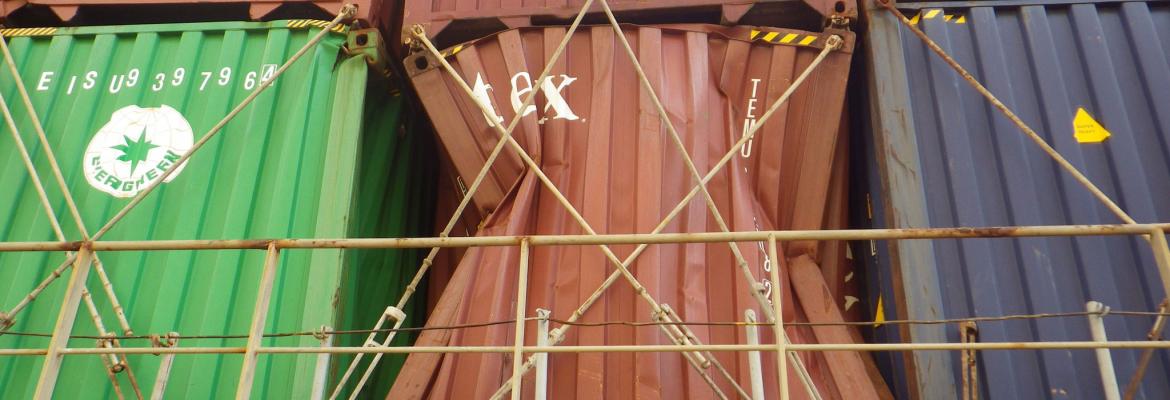
- Contract signed for YM Efficiency clean-up media release.
- YM Efficiency operation factsheet
- Mick Kinley writes: From their inaction to date, Yang Ming and its insurer have no intention of cleaning up the 60 containers that have been identified.
- February community event presentation (PDF 3.7 MB) PDF3.68 MB
- Watch the footage showing an ROUV attaching lifting hooks to a container prior to the ship’s crane lifting the container into the steel recovery basket for retrieval onto ship’s deck.
- See our footage of the first container to be offloaded from MV Pride for waste processing.
- Watch the clean out of a container full of chairs.
- See how sub-sea robotics are used to separate containers, raise tonnes of abandoned containers and clear the seabed. You can also see how waste crew onshore are working to process rubbish for salvage, recycling and landfill:
Recognition of qualifying sea service for Royal Australian Navy personnel
For those listed below, who are either currently serving in the RAN, or have left the RAN, we may recognise qualifying sea service towards an International Convention on Standards of Training, Certification and Watchkeeping for Seafarers 1978 as amended (STCW) master, deck or engineer certificate of competency (provided certain requirements are fulfilled such as vessel size, engine power, etc.):
- RAN Ratings (specialist seaman department)
- RAN Maritime Warfare Officers (Maritime Warfare department)
- RAN Leading Seamen, Petty Officers, Chief Petty Officers or Warrant Officers (Marine Engineering or Electrical Technical department).
Our requirements are set out in:
- Marine Order 70 (Seafarer certification) 2014
- Marine Order 71 (Masters and deck officers) 2023
- Marine Order 72 (Engineer officers) 2014
- Marine Order 73 (Ratings) 2014
- Marine Order 74 (Masters and deck officers – yachts) 2015
The above Marine Orders give effect to the International Convention on Standards of Training, Certification and Watchkeeping for Seafarers 1978 as amended (STCW).
In determining equivalence in service from section 20 of Marine Order 70 (Seafarer certification) 2014 and equivalence in training section 21 of Marine Order 70 (Seafarer certification) 2014, AMSA has thoroughly investigated RAN training schemes and identified gaps to be completed for the purpose of issuing a certificate of competency in accordance with STCW.
Qualifying sea service
Fully documented seagoing service as a rating or Maritime Warfare Officer in the maritime warfare department or Leading Seaman, Petty Officer, Chief Petty Officer and Warrant Officer in the marine engineering or electrical department of the RAN, on RAN vessels, may be accepted as qualifying sea service for the purpose of qualifying for a STCW certificate of competency.
You must provide evidence to support the RAN sea service you are asking us to recognise and may include PMKeyS printouts and other documentation to support your sea service assessment. We reserve the right to request further evidence of qualifying sea service if required. We may also discount all or part of the sea service if it is considered of little or no relevance to the certificate being applied for.
If you believe you have sufficient qualifying sea service for a STCW certificate you should, in the first instance, have your qualifying sea service formally assessed by AMSA. To apply for a qualifying sea service assessment, you should complete form AMSA419 and lodge it at a participating Australia Post retail outlet .
At the time of lodgement, you will be asked to pay a fee for the qualifying sea service assessment.
Qualifying sea service limiting factors
1. Once you have gained your first STCW certificate of competency, qualifying sea service required for future STCW certificates will be accrued from the date of issue of your first STCW certificate of competency (i.e. sea service gained when serving in the RAN and prior to the issue of your first STCW certificate will not be accepted for your second and subsequent STCW certificates). However, we will accept qualifying sea service accrued on RAN vessels after the issue of your first STCW certificate of competency if you remain serving within the RAN.
2. Qualifying sea service on a RAN vessel may be recognised when the vessel is underway for:
- At least two-thirds or more of the RAN posting—the posting being the whole period the person was posted to that vessel—accepted in full; or
- Less than two-thirds of the RAN posting—the actual period underway plus 50 per cent of that period.
Submarine qualifying sea service
Engineer certificates: fully documented qualifying sea service on RAN submarines may be accepted in full towards an engineer certificate of competency.
Master and deck certificates: fully documented qualifying sea service on RAN submarines may be accepted towards a Master or deck certificate of competency as follows:
- Watchkeeper deck (STCW Reg. II/1) - a maximum of four and a half months (i.e. 25%) of the required 18 months qualifying sea service.
- Chief mate (STCW Reg. II/2) - a maximum of three months (i.e. 25%) of the required 12 months qualifying sea service since holding STCW Watchkeeper deck or RAN Bridge Warfare Certificate and RAN Navigation Watchkeeping Certificate.
- Master less than 3000 GT or Master (STCW Reg. II/2) - a total maximum of nine months (i.e. 25%) of the required 36 months sea service since holding STCW Watchkeeper deck or RAN Bridge Warfare Certificate and RAN Navigation Watchkeeping Certificate
Ratings
The sea service of ratings who have served in the specialist seaman department (for example Boatswain category) of the RAN, on RAN vessels, may be recognised as sea service towards obtaining a certificate of competency as Watchkeeper deck.
Maritime Warfare Officer
The sea service of a Maritime Warfare Officer in the Maritime Warfare department of the RAN, on RAN vessels, may be recognised as qualifying sea service towards obtaining a certificate of competency as Watchkeeper deck. Chief mate, Master less than 3000 GT or Master.
Leading Seaman, Petty Officer, Chief Petty Officer and Warrant Officer (Marine Engineering or Electrical Technical)
The sea service of Leading Seamen, Petty Officers, Chief Petty Officers and Warrant Officers who have served in the Marine Engineering or Electrical Technical department of the RAN, on RAN vessels may be recognised as qualifying sea service towards obtaining a certificate of competency as Engineer Watchkeeper, Engineer class 2 or Engineer class 1.
Note: Applications for sea service assessments, recognition of qualifying sea service and recognition of training from personnel who have served or are serving in foreign navies will not be accepted or considered by AMSA and should be referred to the maritime administration of that country. For this reason, AMSA will not enter into dialogue to discuss this matter with you.
Our vision, mission, values and aspirations
Vision
Safe and clean seas, saving lives.
Mission
Ensuring safe vessel operations, combating marine pollution, and rescuing people in distress.
Values
Our values represent our people:
Professional—we act with integrity and are pragmatic in our approach.
Collaborative—we value and respect others and work together to achieve our objectives.
Dedicated—we are committed to AMSA’s mission and responsive to the needs of our customers and stakeholders.
Accountable—we take responsibility for our decisions and actions.
Aspirations
We will:
- take the lead in maritime safety regulation, maritime environmental emergencies, and maritime and aviation search and rescue
- promote and implement safety and environment policies, nationally and internationally
- have strong and confident strategic partnerships with stakeholders
- be a preferred choice for career development and advancement
- have information systems that are reliable and up to date to support our operations, industry and community.
Our social media presence
Here's where you can find us:
Join our Facebook...
Follow us on Linkedin
X
Follow our posts on @AMSA_News.
YouTube
Find all our videos at youtube.com/AMSAupdates
Social media terms of use
We encourage input and interaction on our social media pages. Comments or posts that contain any form of bullying or abuse, racial or religious slurs, coarse or inappropriate language will be removed.
We moderate comments or posts that promote commercial or political interests, unauthorised events, or radical ideologies. Comment removal is at the discretion of AMSA.
Our social media terms of use:
- affirm that contributions to our online spaces—including our Facebook and X pages—are welcomed from all
- ensure contributions are appropriate, respect the needs and sensitivities of others, and are lawful.
Operational updates—YM Efficiency
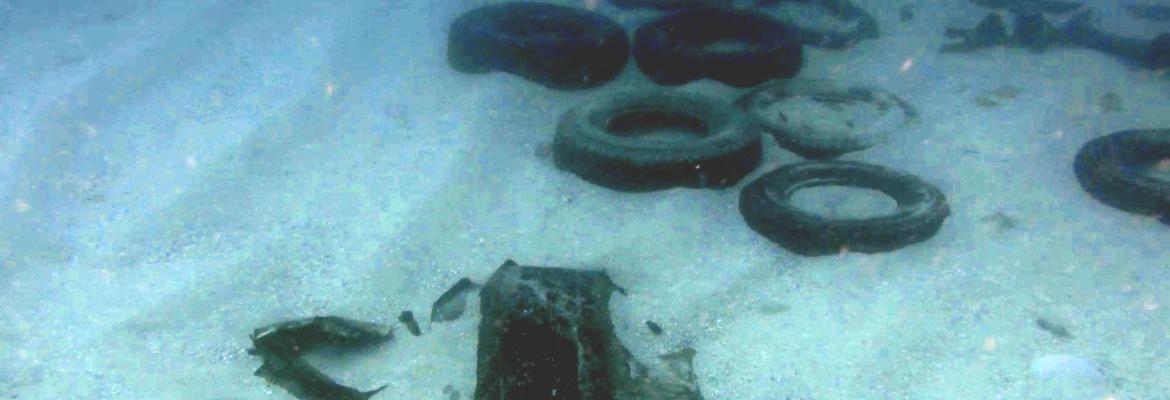
Hundreds of tonnes of container waste processed
Onshore crew at Port of Newcastle have finished the enormous task of processing 720 tonnes of waste recovered from waters off the Hunter Coast.
The final six of 63 identified YM Efficiency containers recovered by the MV Pride were discharged on 8 May and processing was completed on 10 May.
The containers holding furniture, chip packets and other foodstuffs, were opened and processed for safe disposal.
During a four-week period from 12 April when the first containers were discharged onshore, crew identified 440 tonnes of general solid waste for landfill.
In addition, 195 tonnes of metal, including empty containers were sent for scrap metal processing, 67 tonnes of tyres mustered for recycling and 18 tonnes of liquid waste collected for safe disposal.
Overall the operation took 34 days, including 7.5 days of weather delays and no additional marine pollution reported.
We thank seafarers from both Australia and overseas who have completed this work away from their homes and families in this time of a global pandemic.
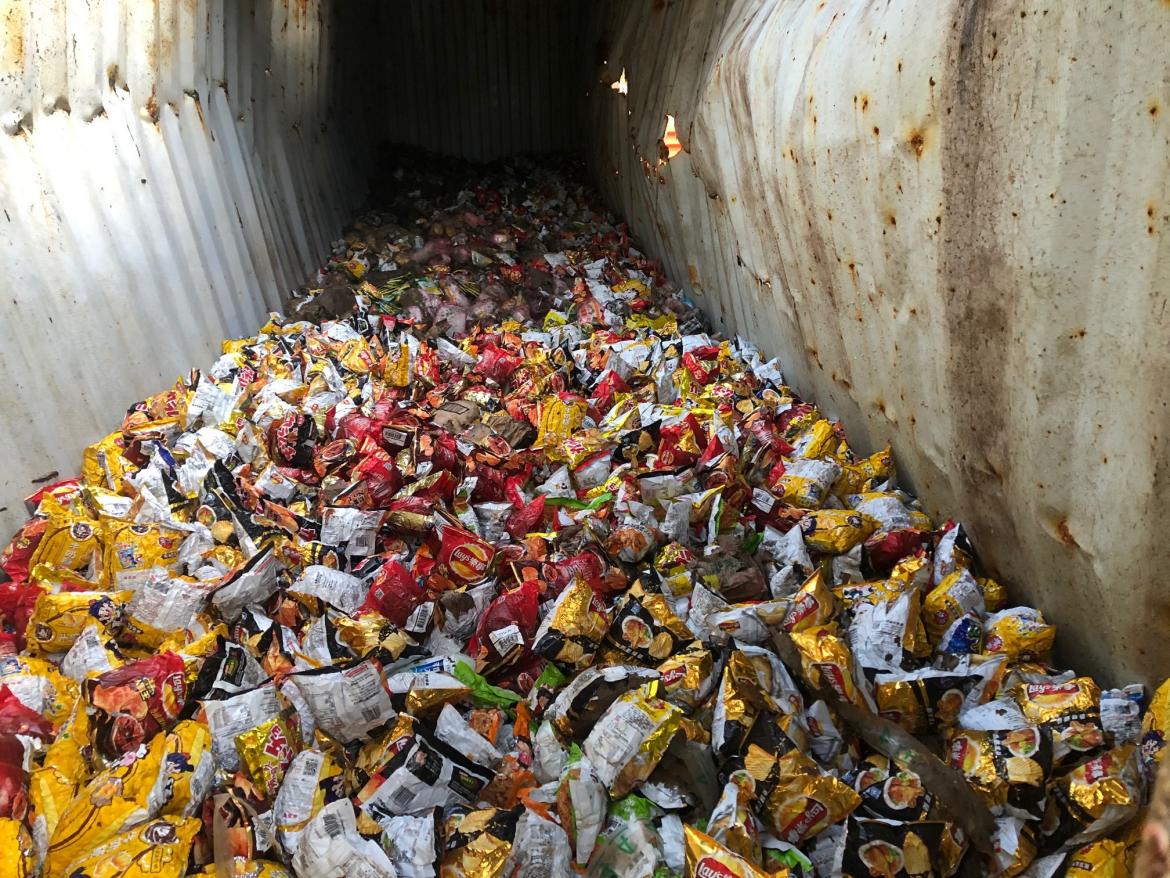
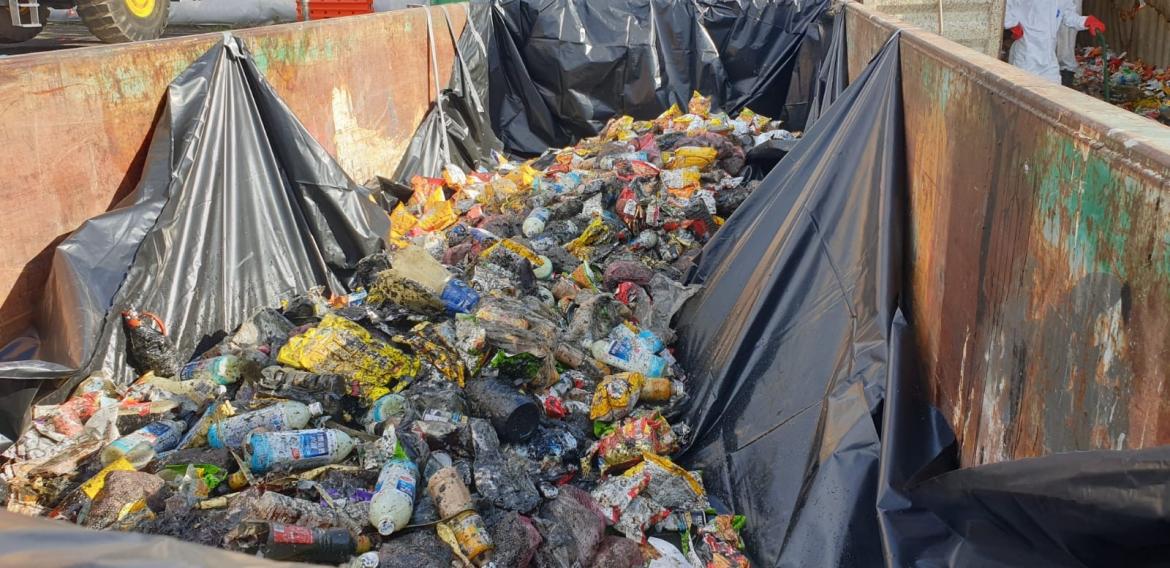
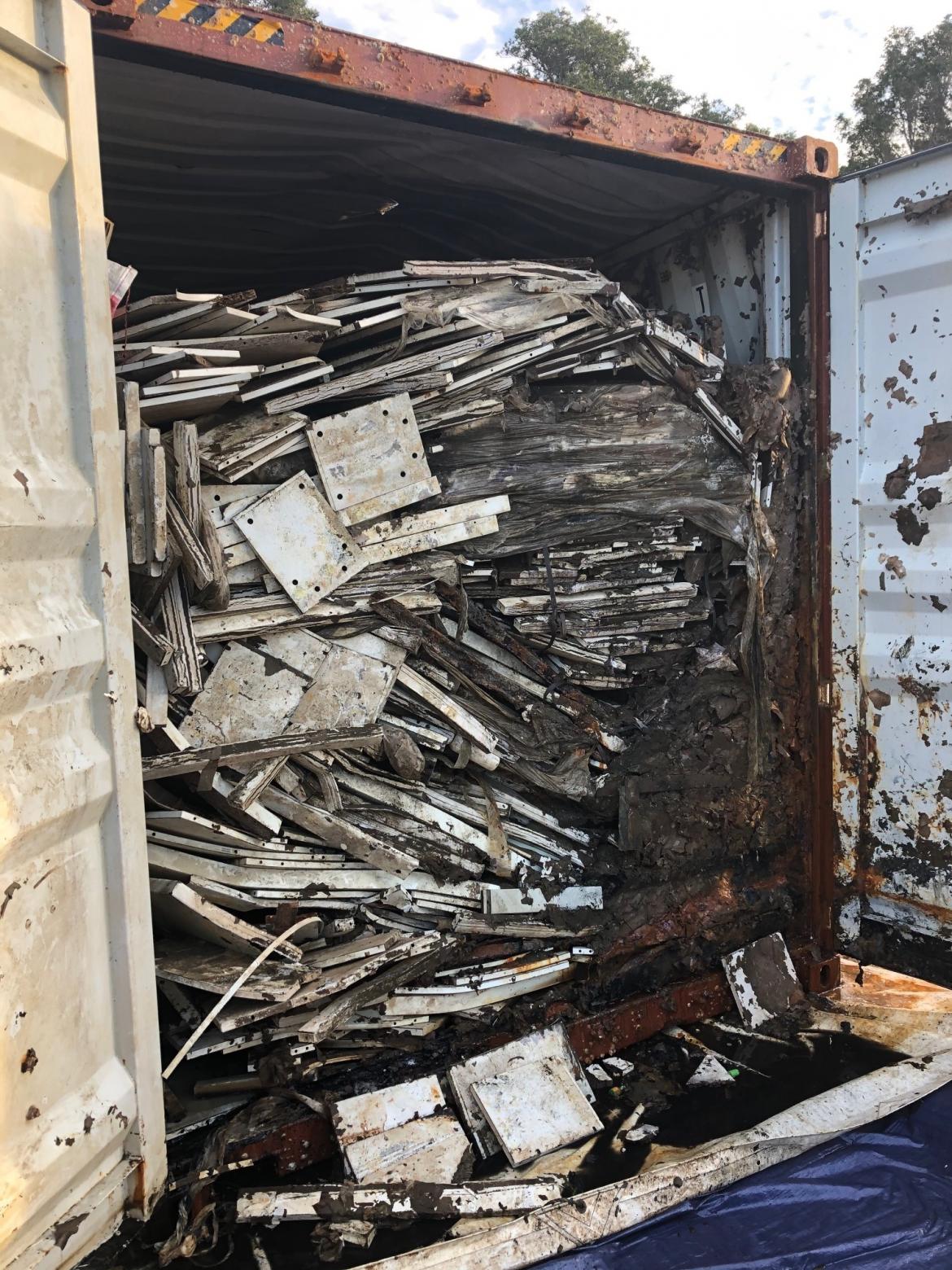
- 8 May: Five-week coastal clean-up ends
All 63 identified shipping containers lost overboard from the YM Efficiency in June 2018, have been recovered off the Hunter Coast.
Offshore construction vessel, MV Pride, which carried out the five-week operation, has returned to Port of Newcastle to discharge the final six containers onshore.
It brings an end to subsea operations to recover thousands of tonnes of waste and pollution that has mired Newcastle-Port Stephens coastal communities for almost two years.
The final six containers will be processed by waste crews for salvage, recycling or landfill.
We are thankful to the seafarers who have worked on this operation.
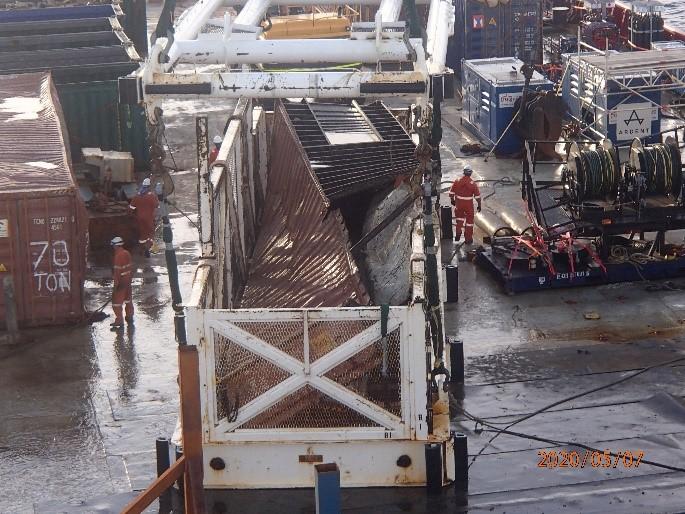
Crushed and damaged containers will be sent straight to a metal scrapping facility. 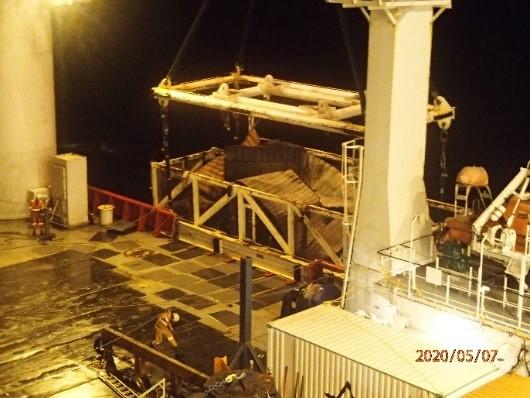
Final six recovered containers have been delivered to shore for processing.
- 7 May: Final days of retrieval operation
Crew on MV Pride have recovered 36 steel beams and their broken container, plus a container holding foodstuff and beverages.
There are three remaining steel beams to be removed from the seabed, followed by a site survey.
To date, 59 containers have been retrieved and there are four yet to be recovered.
Conditions are expected to improve, aiding the efforts to bring offshore operations to a close.
Two containers originally holding 39 steel beams will be processed as scrap metal onshore.
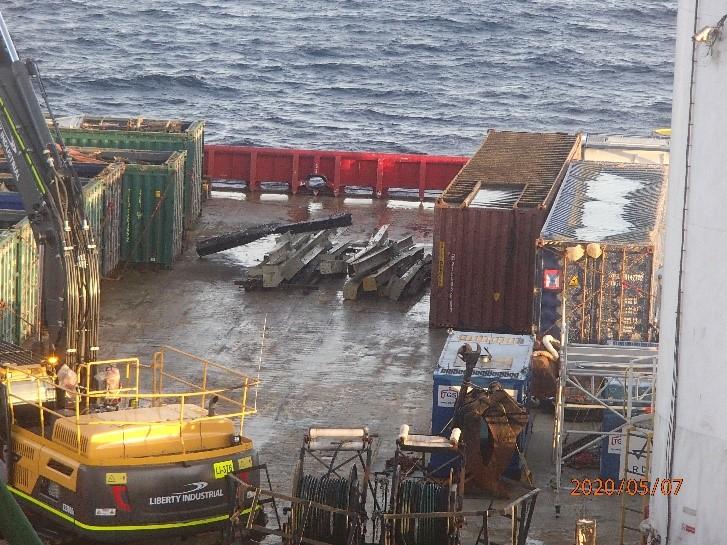
Two containers originally holding 39 steel beams will be processed as scrap metal onshore.
- 6 May: Steel beams slow down recovery efforts
Operations have resumed overnight to retrieve debris and the final six identified containers off the Hunter Coast.
Crew recovered a hydraulic tank and motor, a corner section of a container and discovered two containers split open with a number of steel beams spilling out.
Due to their weight, each beam was lifted separately by MV Pride’s heave compensating crane, which slowed overnight recovery operations. Both containers are yet to be recovered and the site cleared of debris.
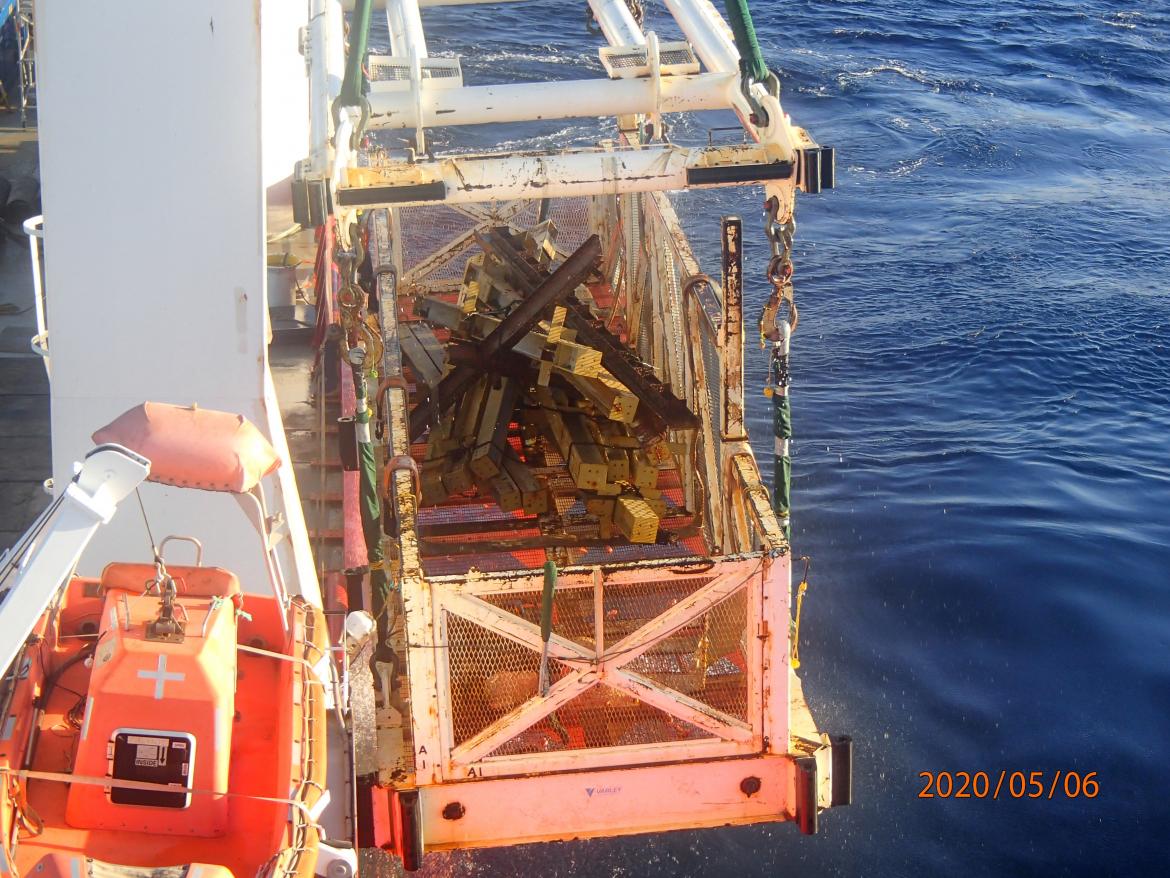
Recovery of steel beams spilled out of containers. 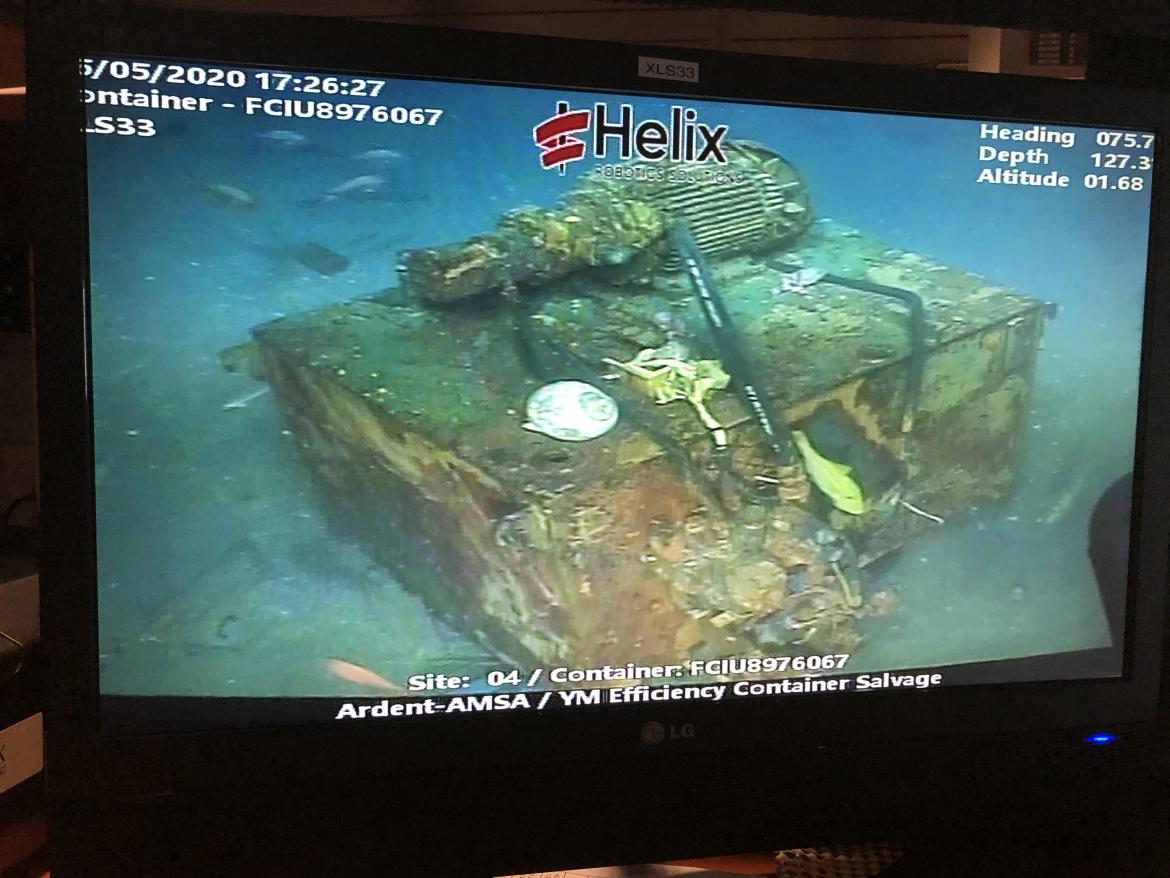
Machinery is prepared for retrieval at one of the final container recovery sites.
- 5 May: Recoveries set to resume
Operational crew on MV Pride are planning to recommence work by this evening to recover the remaining six containers off the Hunter Coast.
Bridge crew are monitoring conditions for changes, with high seas and wind gusts expected to ease off today.
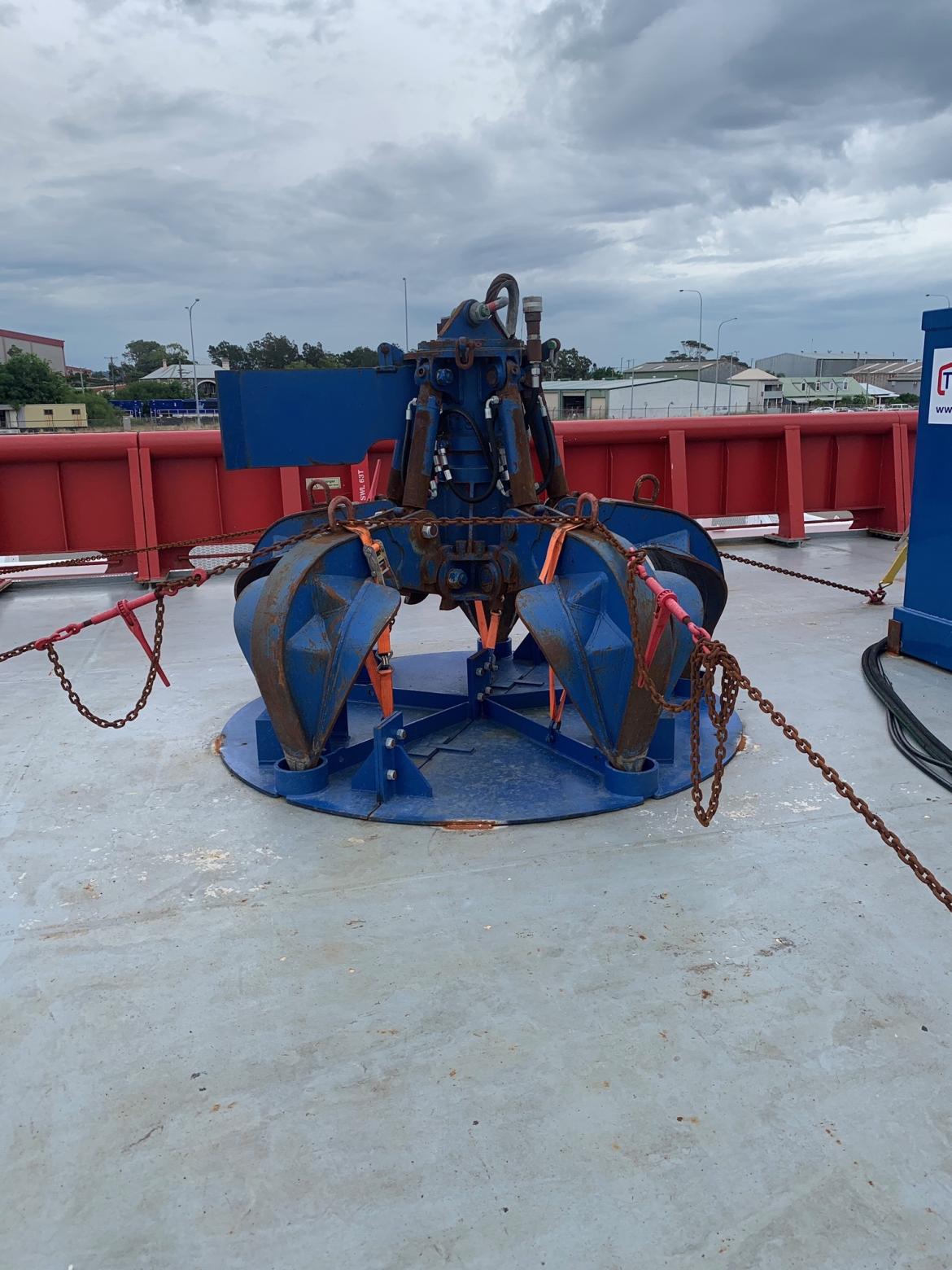
Robotic grab used to collect loose debris from the seabed
- 4 April: Recoveries paused during poor conditions
Salvage operations have been on hold since Friday due to high winds and rough seas.
Bridge crew aboard MV Pride are monitoring conditions for any changes and will resume container recoveries once weather improves off the Hunter Coast.
All discharged containers have been processed by waste crew at Port of Newcastle for salvage, recycling and landfill.
To date, 57 containers have been retrieved and the remaining six containers will be retrieved at the earliest opportunity.
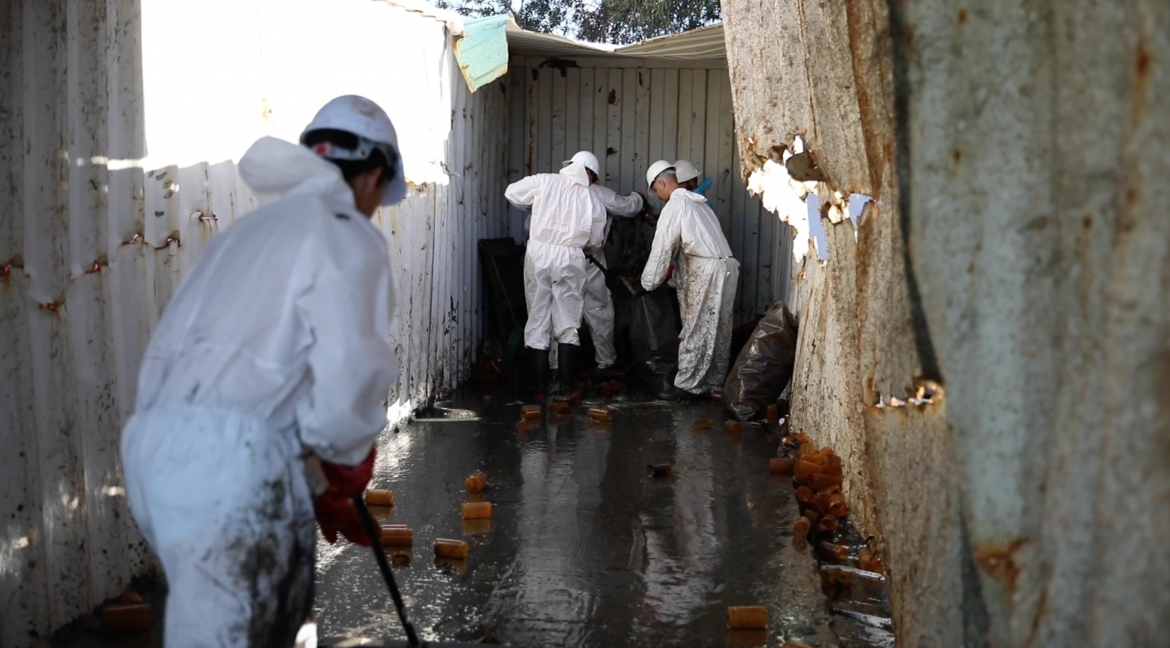
Waste crew have completed onshore container processing until the next tranche is delivered.
- 1 May: Video opens the door on container waste
Waste crews at Port of Newcastle will continue processing tonnes of solid and liquid waste while subsea container recovery operations are on hold.
Retrieval of the final six containers from the Hunter Coast seabed are being paused while MV Pride awaits an improvement to the current high seas and rough conditions.
Onshore, 67 truckloads of general waste and recycling, metal scrap and tyre recycling have been processed and storage tanks for liquid and bunded waste have been pumped out twice for safe disposal.
Around 35 emptied containers have been metal scrapped and mobility scooter batteries will be transferred to a licensed hazardous waste facility.
Offshore operations are expected to resume next week or when weather conditions improve.
You can check out our amazing footage of subsea and vessel operations, and witness the opening of the first few containers onshore.
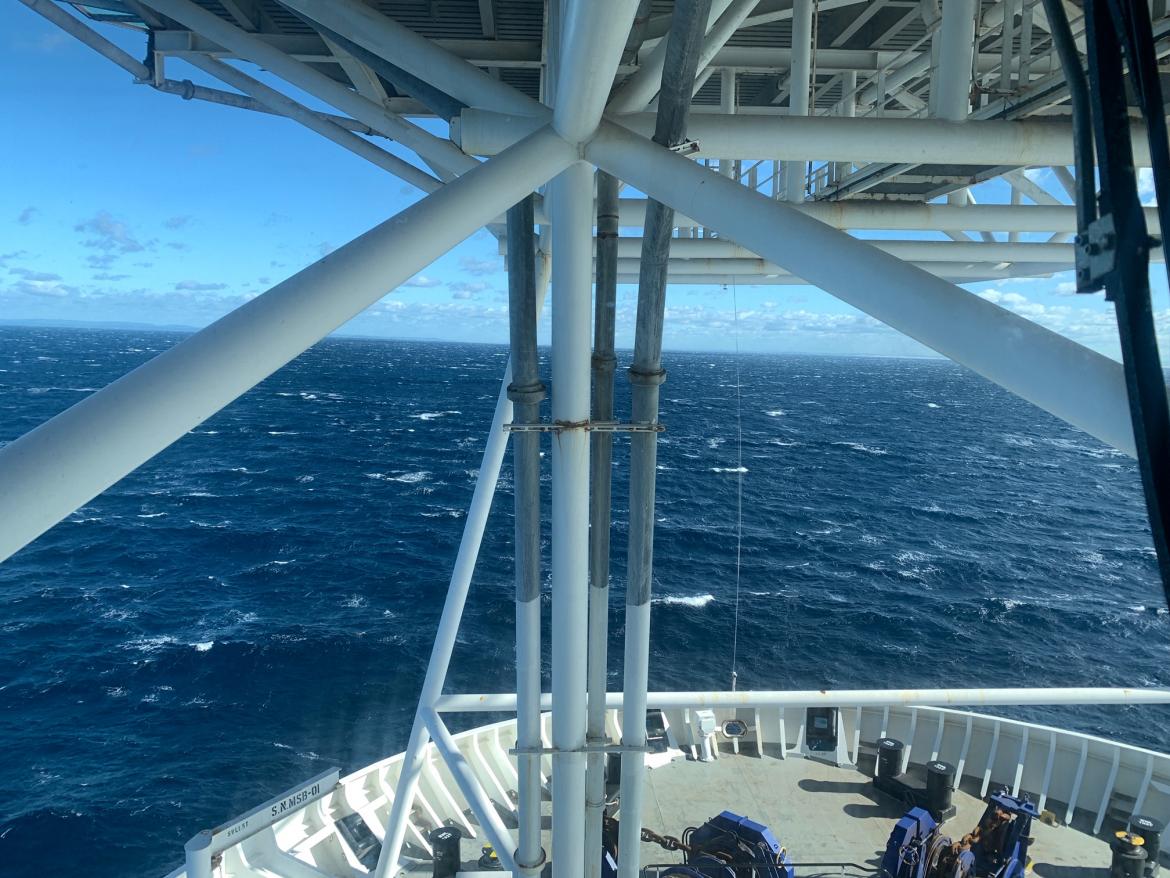
Rough weather has stalled offshore operations, while crews working onshore are still processing tonnes of waste."
- 30 April: Waste processing continuing onshore
Three damaged containers were retrieved off the Hunter Coast overnight before operations were halted due to rough conditions.
Containers holding a machinery test bed, toilet paper and nappy absorbent were stored on board MV Pride and crew carried out site surveys for loose debris.
At Port of Newcastle, waste processing of 11 containers is complete, including cleaning and disposal of discharged containers. There are three containers left to process ahead of site preparations for the next load of containers to be discharged ashore.
To date, 57 containers have been retrieved and there are six identified containers yet to be recovered.
High seas and increased wind speeds expected over the weekend will likely delay the recovery of the remaining containers until early next week.
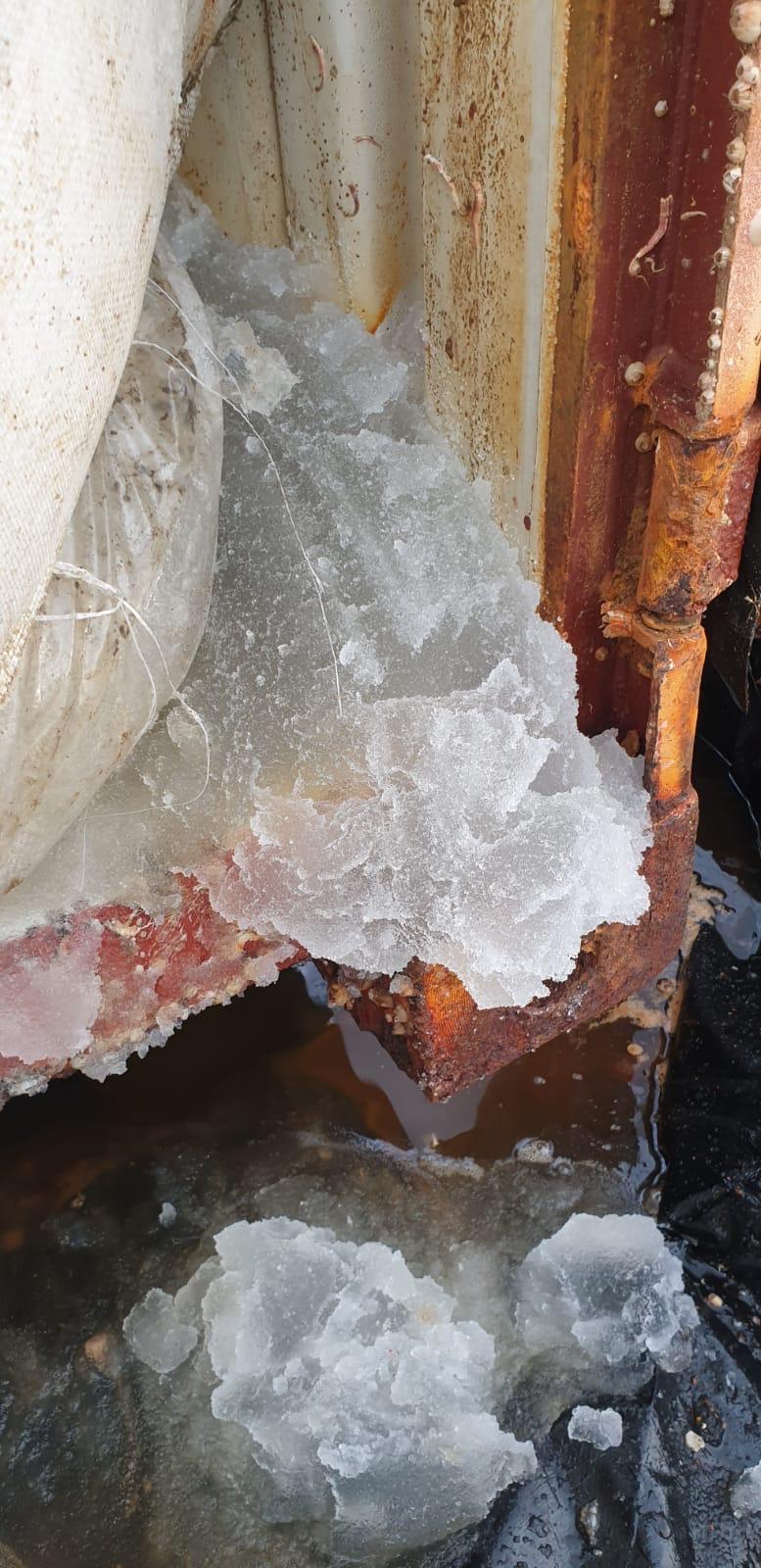
Waste crew are processing another container of nappy absorbent 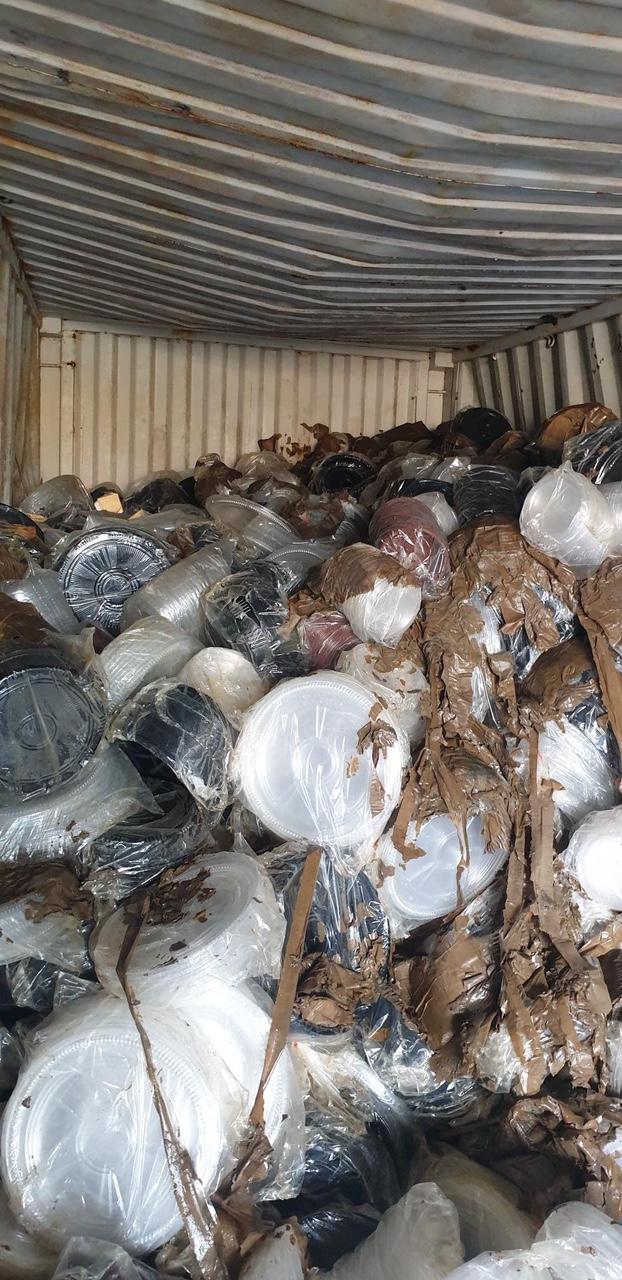
Plastics will be sorted for recycling where possible
- 29 April: 70-tonnes of furnishings recovered overnight
Crew aboard MV Pride retrieved two containers of toilet paper and a 70-tonne container of furnishing products from the seabed last night.
They also pulled a ghost net out of the ocean.
MV Pride is working on retrieving containers in the outer reaches of the salvage site, requiring extensive sailing time in expected worsening conditions.
Onshore, 10 emptied containers have been sent directly for metal scrapping. Processing of 14 containers is underway, including a 46-tonne cargo of nappy absorbent (sodium polyacrylate) retrieved last week.
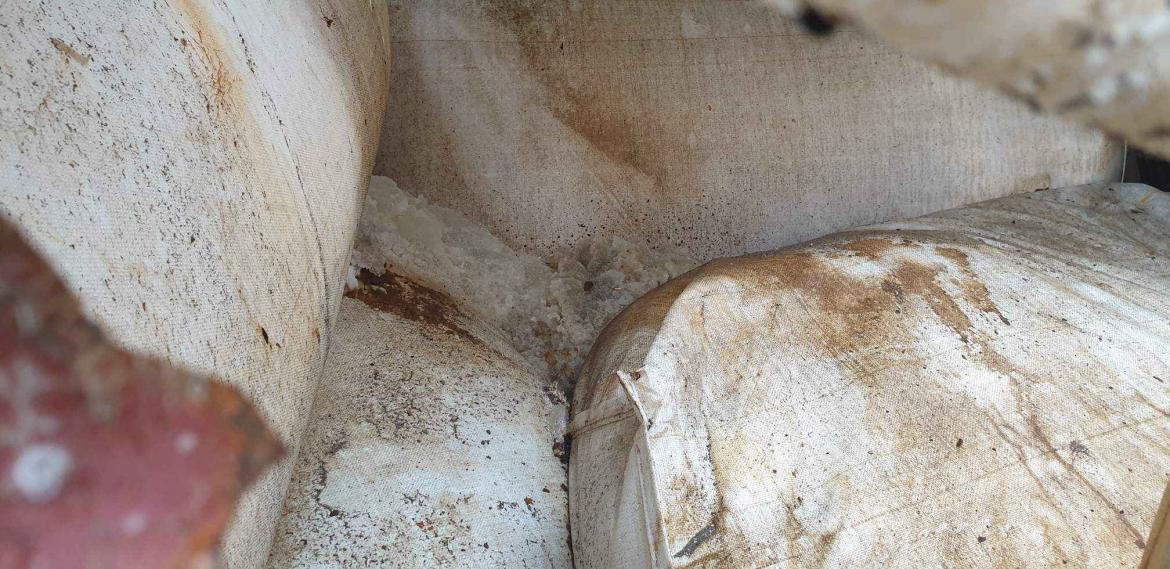
Processing of a 46-tonne container of nappy absorbent is underway at Port of Newcastle.
- 28 April: Another “lost” container discovered during salvage
Another missing container off the Hunter Coast is now accounted for after it was discovered during salvage operations yesterday. It brings the total number of containers to be recovered during this operation to 63, with only 13 still unaccounted for.
Ten containers were lifted from the seabed between Friday night (24 April) and this morning. Two containers proved difficult to separate as their twist locks were seized and had to be cut, causing delays to their salvage.
On Monday (27 April), MV Pride returned to the port of Newcastle and discharged 24 containers for processing. The ship returned to sea on Monday evening to retrieve the remaining 12 identified containers.
The containers currently being processed at the onshore waste facility contain a range of materials including plastic jars, car parts, crockery, toilet paper and office chairs.
The weather for the next few days is favourable however deteriorating weather conditions are expected to set in on Thursday.
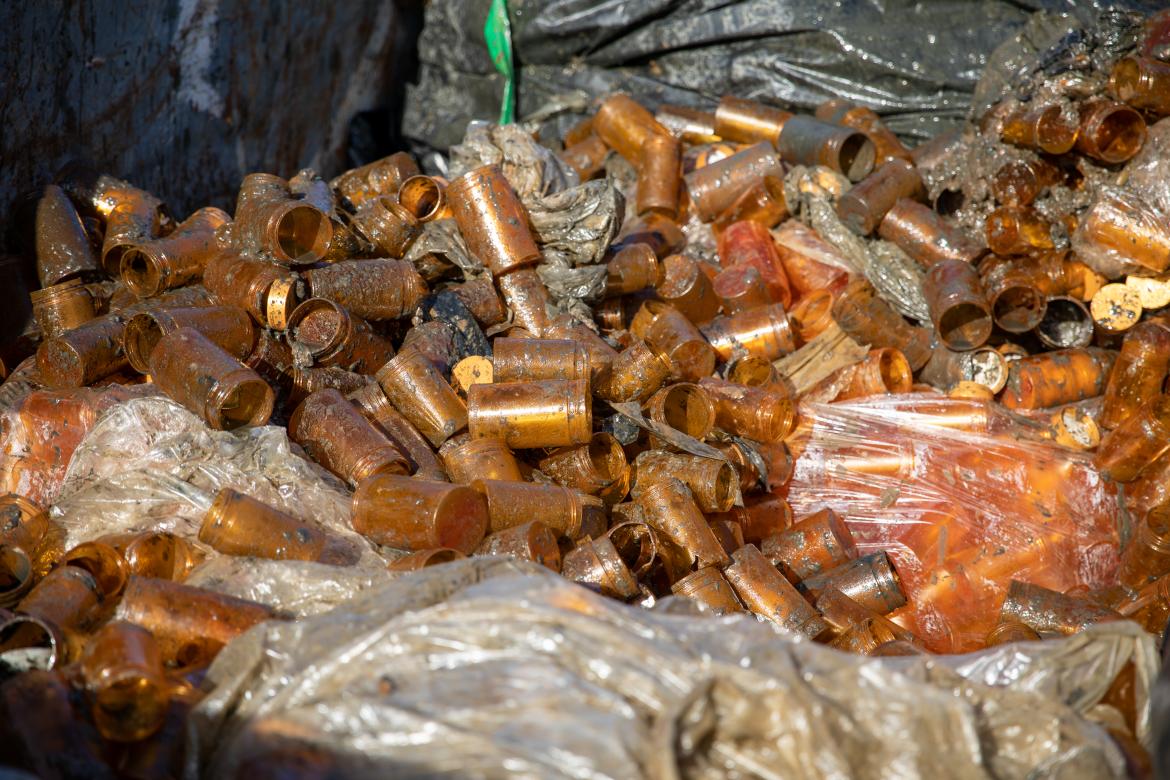
Plastic jars are offloaded at Port of Newcastle 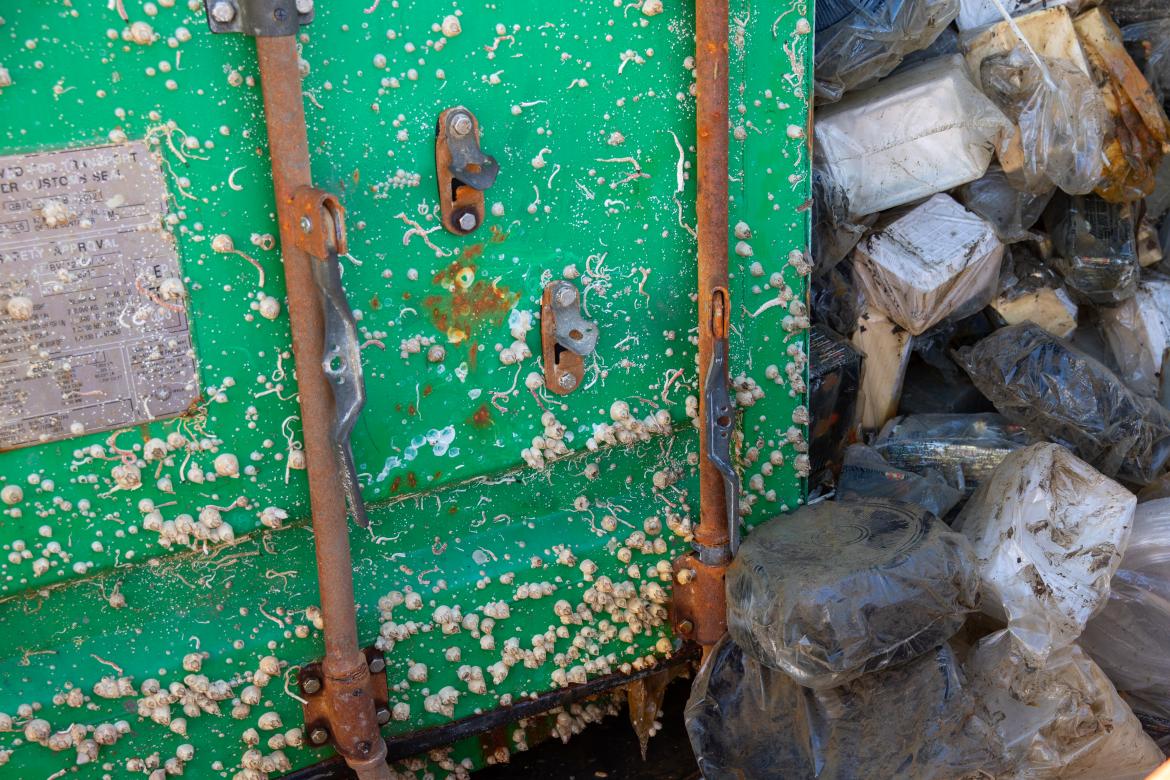
Plastics are among the contents of 24 containers to be sorted and processed
- 24 April: Broken containers and car parts safely salvaged
Clean-up of auto spare parts littering the seabed is underway along with the retrieval of broken containers off the Hunter Coast.
Four containers were recovered overnight, containing furniture, plastic jars, car parts and office chairs. One of the containers was empty and crushed immediately for metal scrapping at Port of Newcastle.
Robotic equipment including a Remote Operated Underwater Vehicle (ROUV) and grab are working to clear the seabed of the pollution.
Crew aboard MV Pride have retrieved 41 of 62 containers so far and work is underway to prepare the onshore waste processing area for 20-25 containers to be offloaded this weekend.
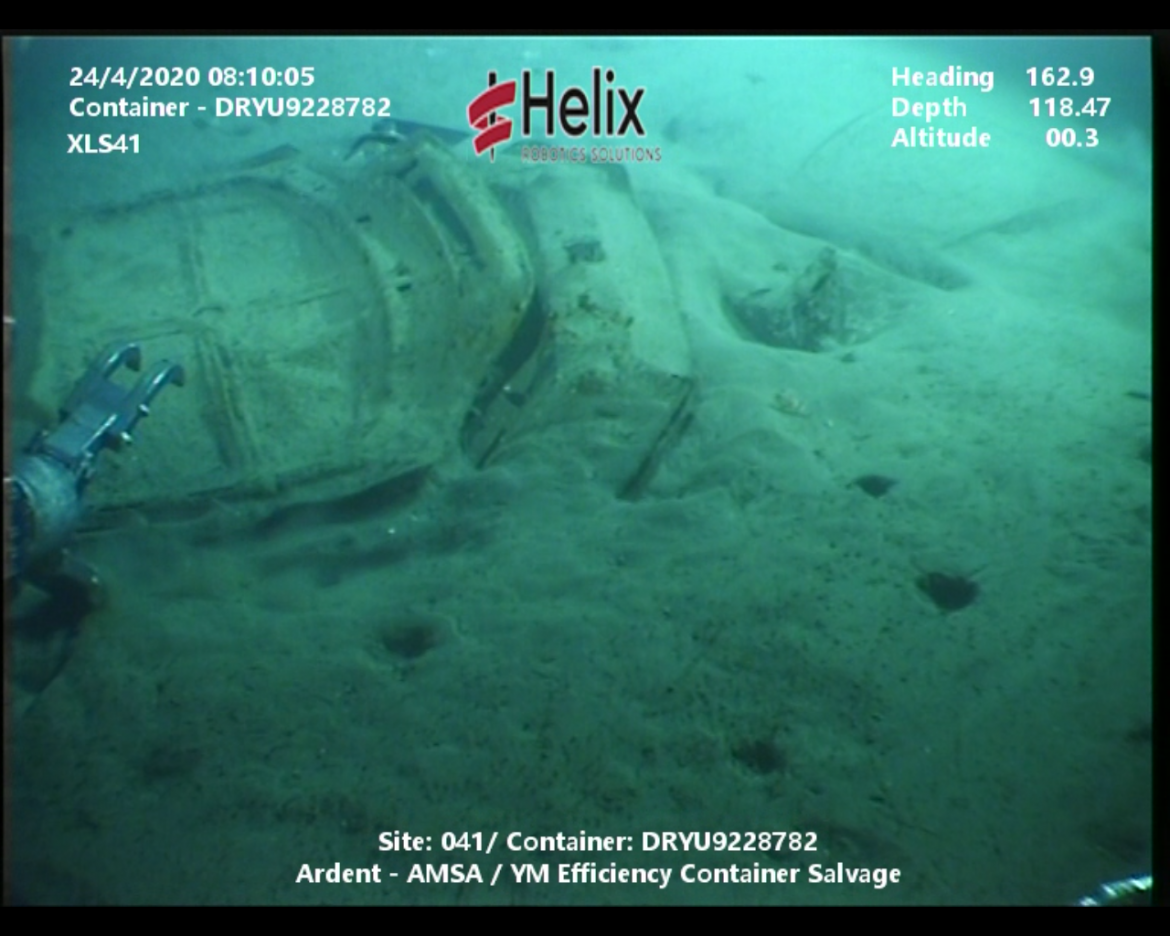
Robotics are used to clear car parts and what looks like a vehicle bonnet. 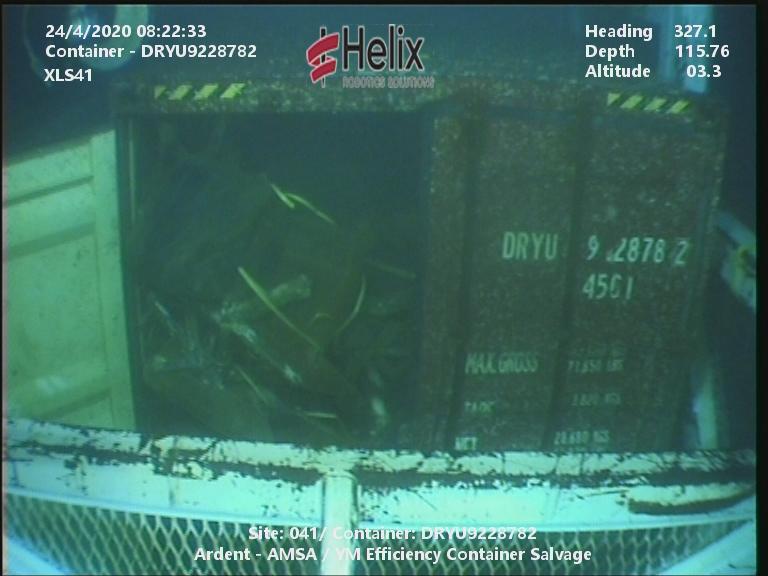
Broken container and furniture will be processed for salvage, recycling and waste onshore.
- 23 April: Salvage image gallery launched
Rolls of carpet, foodstuff, bathroom pods and 46-tonnes of sodium polyacrylate, commonly used as nappy absorbent, are among the contents of four containers retrieved from the seabed off the Hunter Coast overnight.
In the next few days, crew on the MV Pride will use a robotic grab to retrieve a steel beam and a container in poor condition.
To date, 37 containers have been retrieved, with 25 yet to be salvaged.
All retrieved containers offloaded ashore last weekend have been processed and the site cleared for the expected discharge of between 20-25 containers this weekend.
Cylinders reported yesterday are being investigated to ensure correct disposal is carried out.
You can view images of some of the salvage operations and findings in our new photo gallery.
Sign up for our weekly bulletin at OperationRecovery@amsa.gov.au
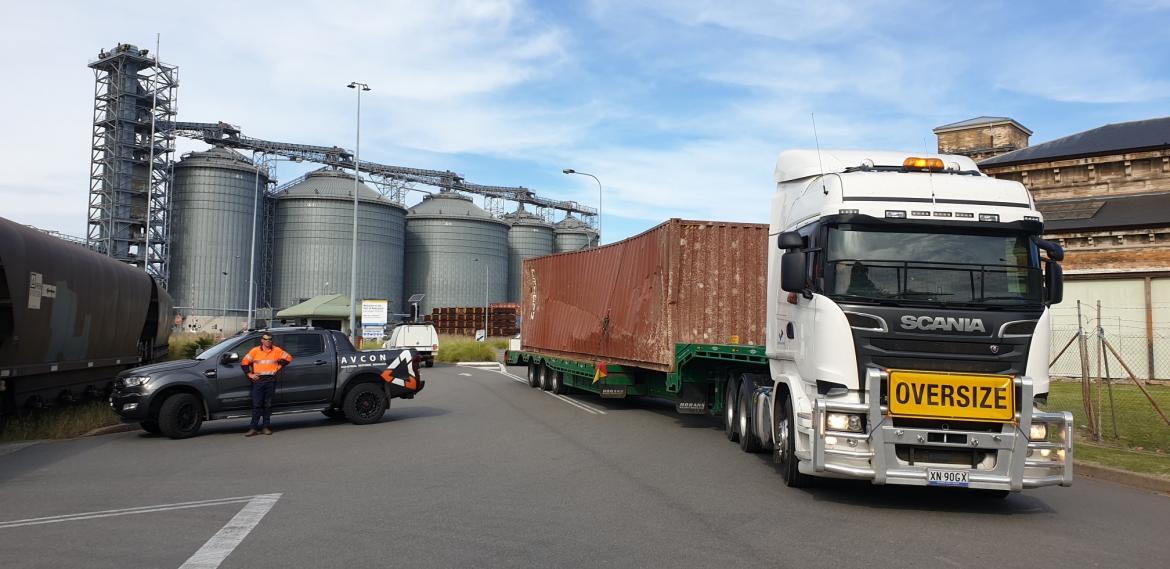
- 22 April: Grab and ROUV to collect loose debris
Several surveys of recovered container sites have been completed, resulting in the collection of loose debris and a stack of timber from the Hunter Coast seabed.
Two containers were retrieved overnight, one was heavily damaged and crushed on the deck of MV Pride and safely stored.
Assorted metal frames and bathroom pods believed to be cargo from the two damaged containers will be retrieved using a grab guided by an ROUV.
Gas bottles, bikes and glassware are among the contents of the containers offloaded at Port of Newcastle on the weekend, as waste processing continues.
All empty containers are being processed as scrap metal.
Gas bottles, glassware and bikes are among the overnight finds from containers opened onshore.
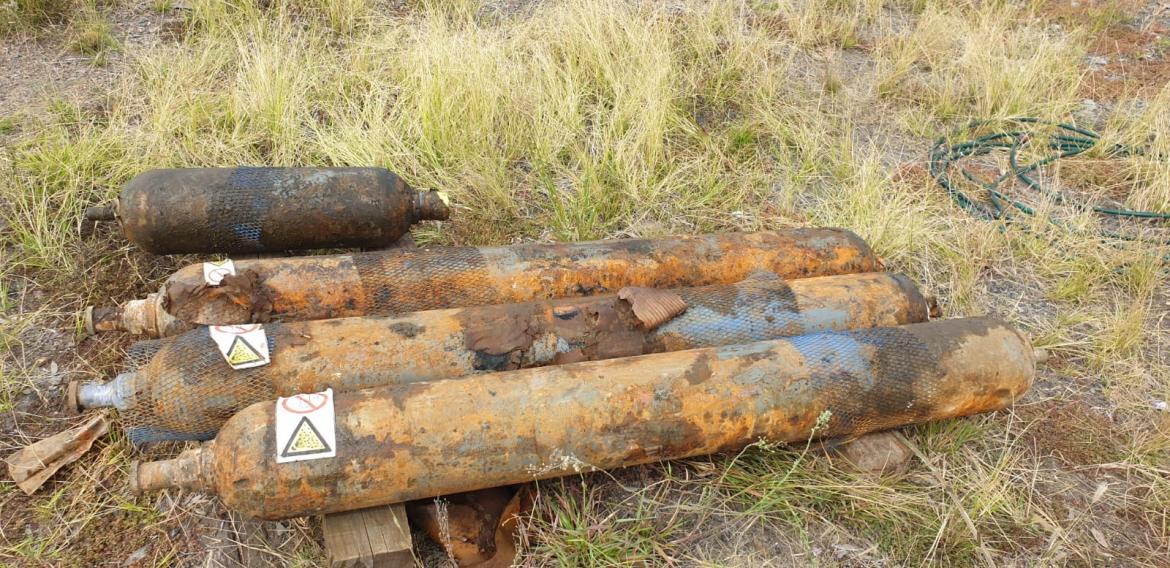
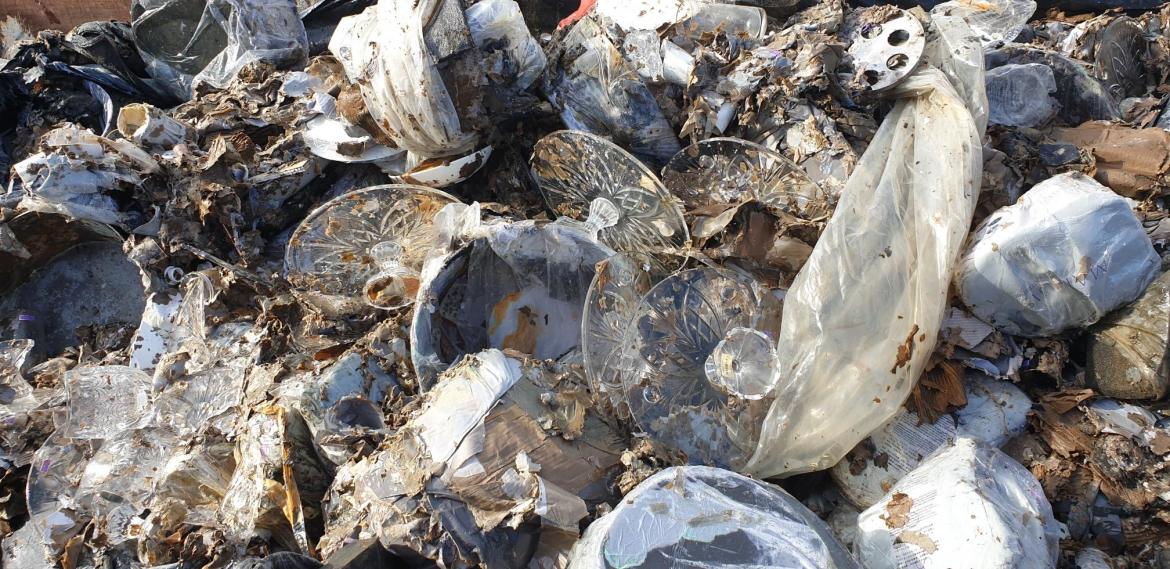
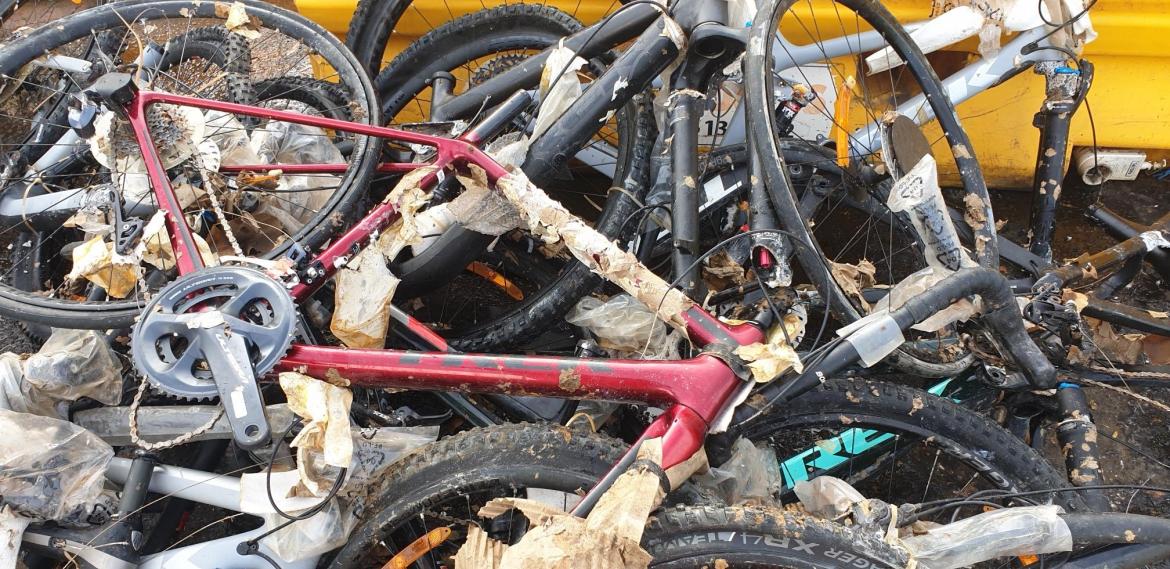
- 21 April: Salvage at halfway mark
The YM Efficiency container salvage operation has reached halfway with 31 of the 62 containers scheduled for retrieval off the Hunter Coast now recovered.
Four containers were recovered overnight and compared to the vessel manifest. They’re expected to hold toilet paper, plastic jars, auto spare parts and bathroom pods.
Broken containers were cut up on the deck of MV Pride and stored for onshore waste processing.
Onshore, eight offloaded containers have been emptied and are ready for scrap metal loading.
MV Pride has returned to three sites to verify structural conditions of several containers following poor visibility over the weekend.
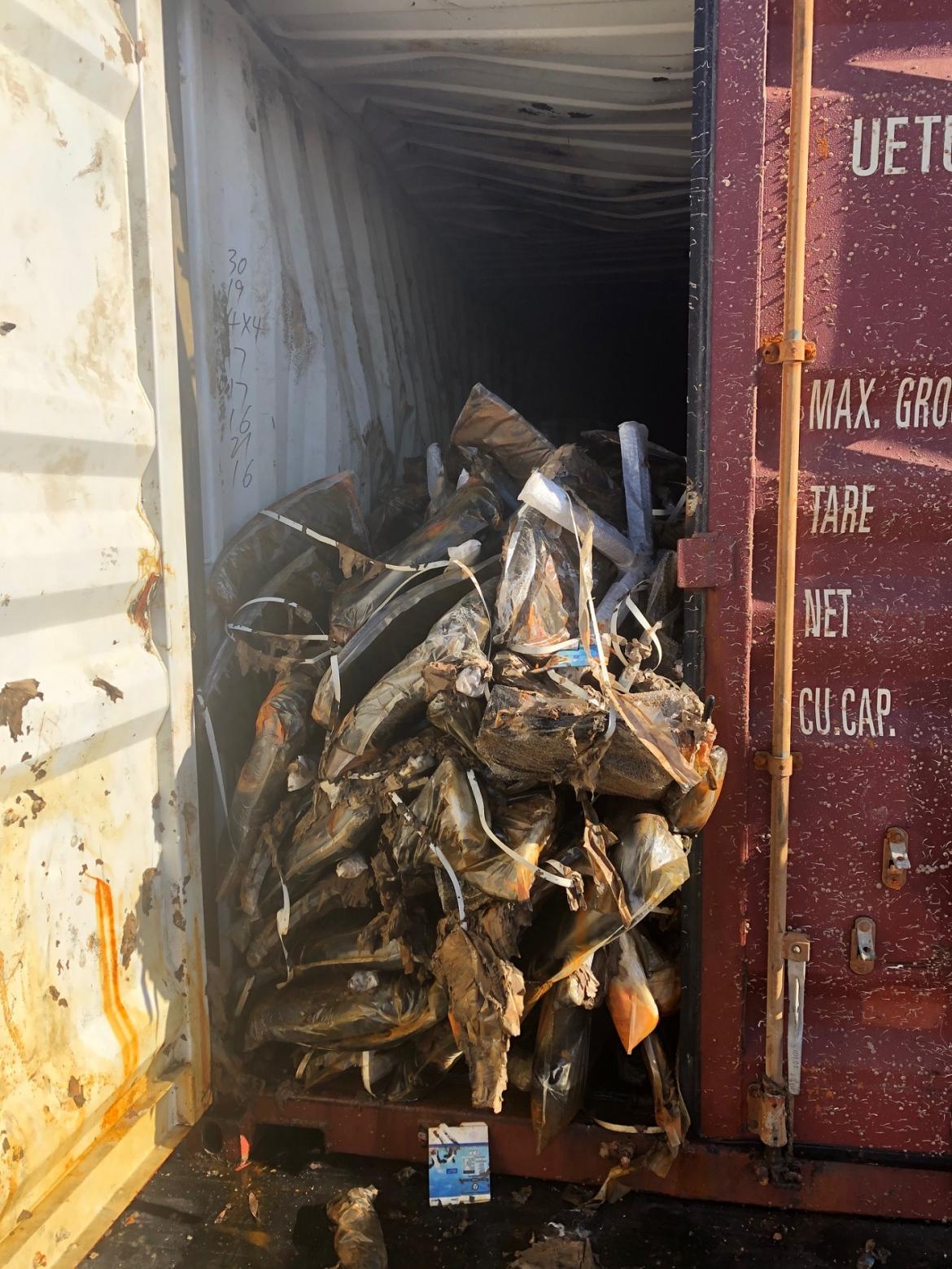
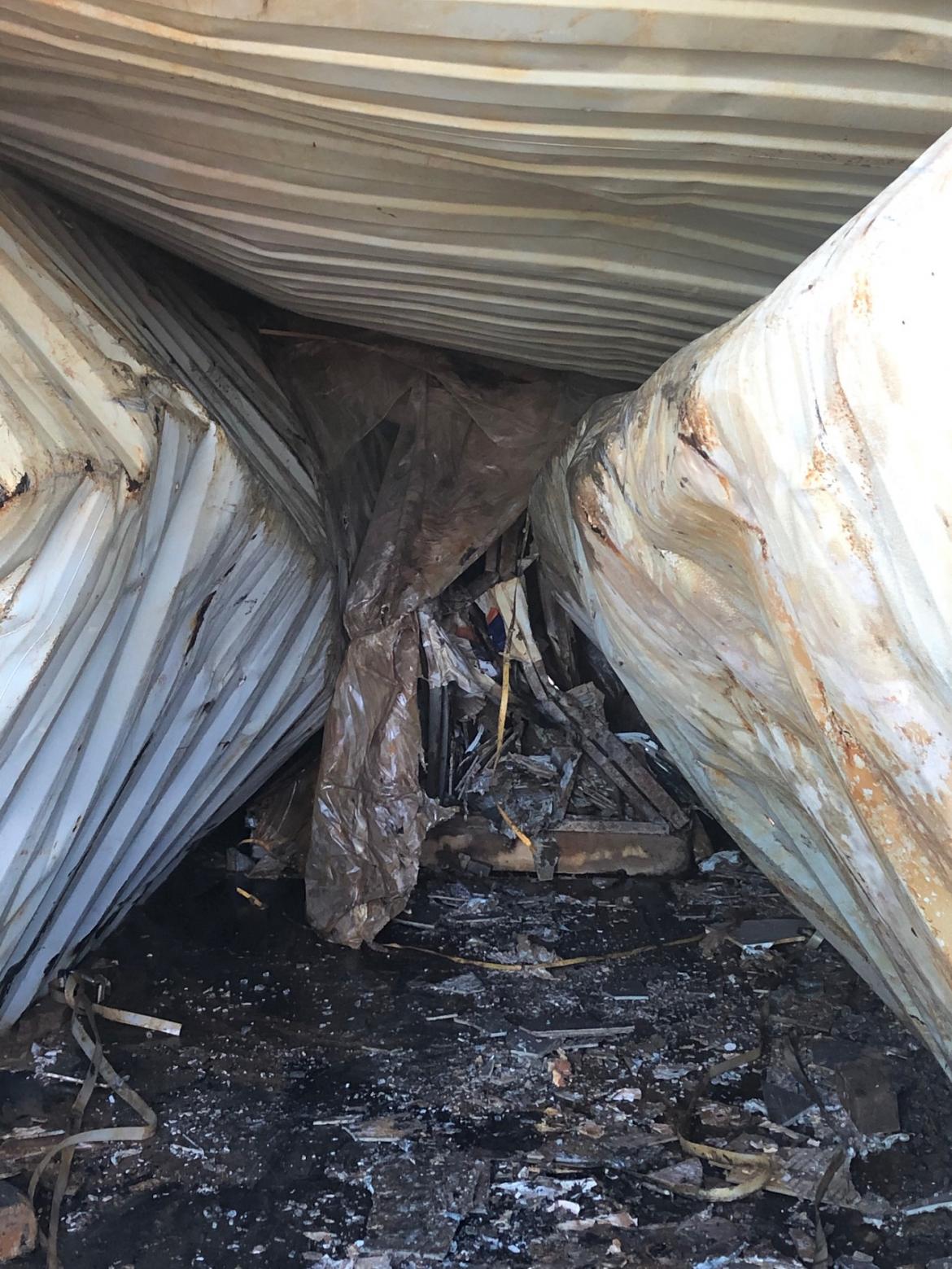
- 20 April: Salvaged bikes stopped in their tracks
Office chairs, electronics, tyres, bicycles and bathroom pods are being processed for disposal after MV Pride offloaded 16 containers at Port of Newcastle during the weekend.
To date, 27 containers have been retrieved from the seabed along the Hunter Coast, including three uplifted on Saturday.
This week, the MV Pride will continue work to retrieve the remaining 35 identified containers, once visibility improves.
A two-metre rolling swell has impeded efforts to conduct site surveys due to less than .25 metres bottom visibility.
Crew have used this time to crush a severely damaged container on the vessel’s deck and store the debris in waste containers for safe disposal ashore.
You can view footage of one of the containers being emptied.
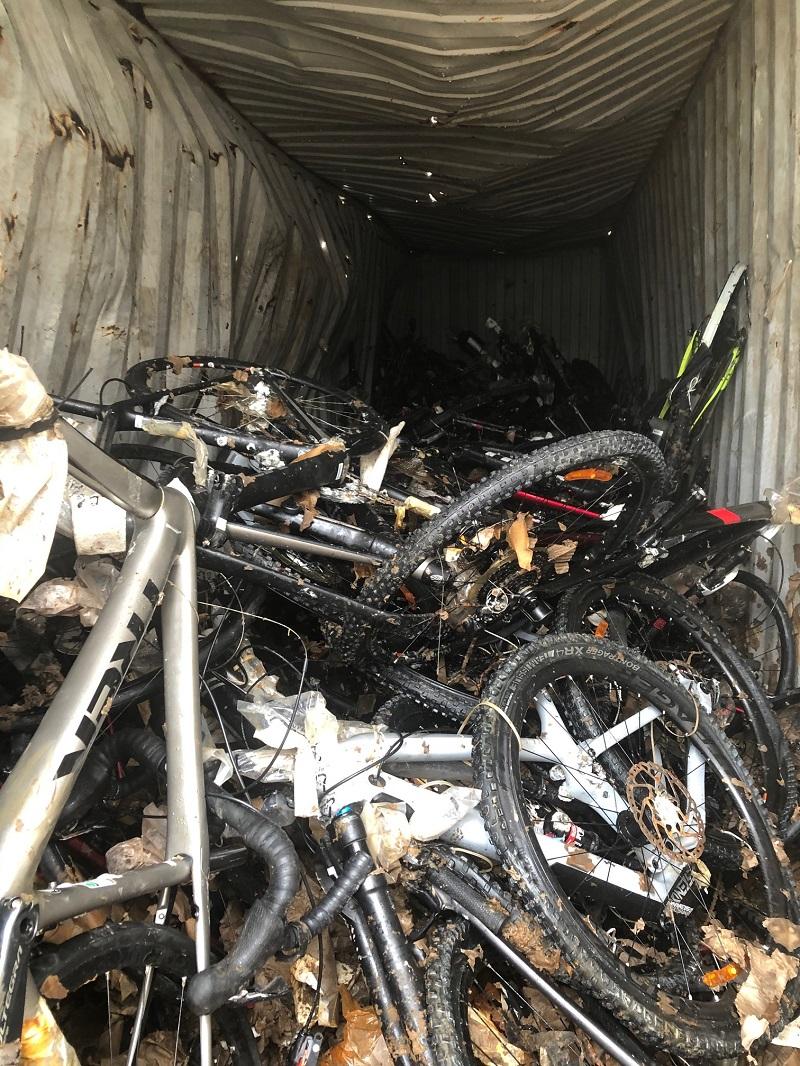
Bikes will be unpacked for waste processing 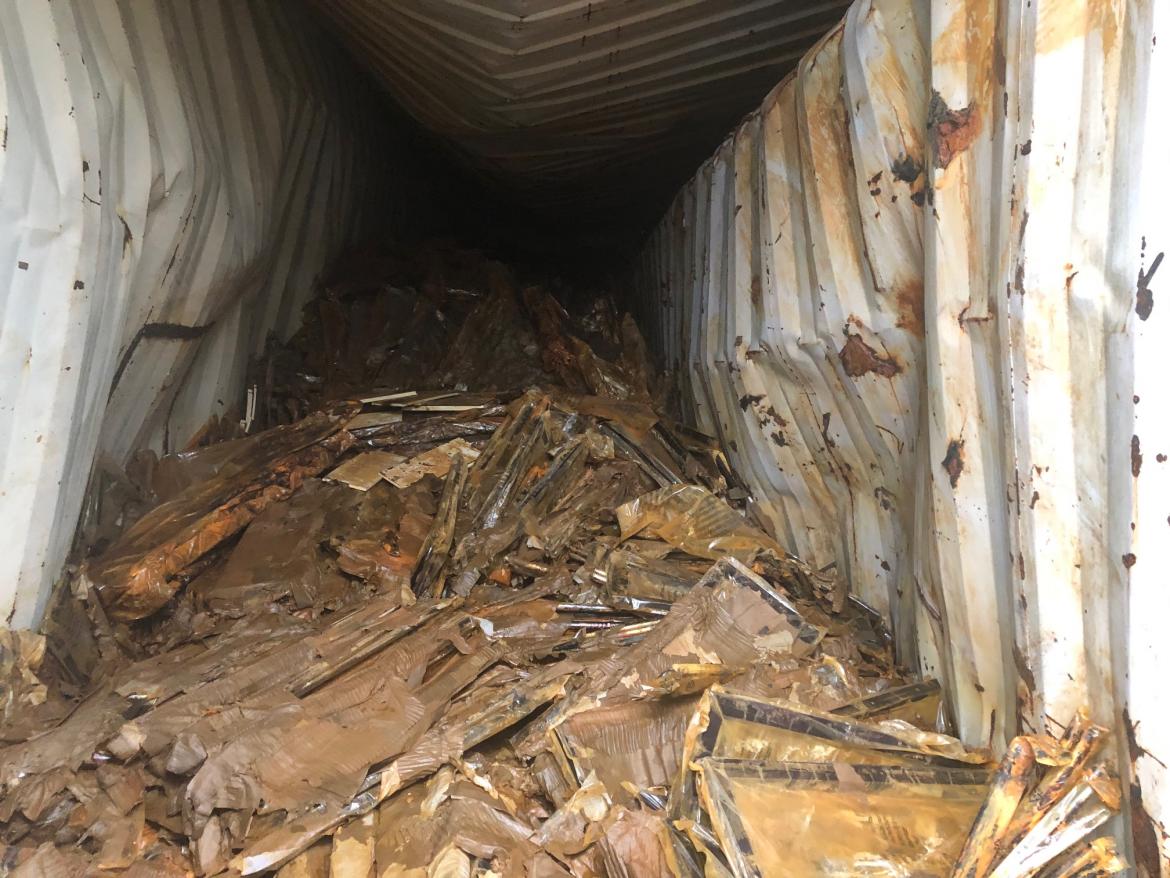
Processing of LED screens and electronic goods is underway
- 17 April: Clean-up underway after three containers separated
Crew on the MV Pride worked overnight to raise four containers from the seabed off the Hunter Coast.
Operations now are underway to clear the seabed of debris from a broken container following deployment of a diamond wheel cutting saw to separate a stack of three containers.
Waste processing of nine containers taken ashore on Monday is continuing at Port of Newcastle where a bobcat is being used to clear out debris from the containers.
A shipment of mobile scooters is being processed and batteries are being separated out for safe disposal.
Weather conditions are forecast as favourable and the salvage is expected to continue over the weekend.
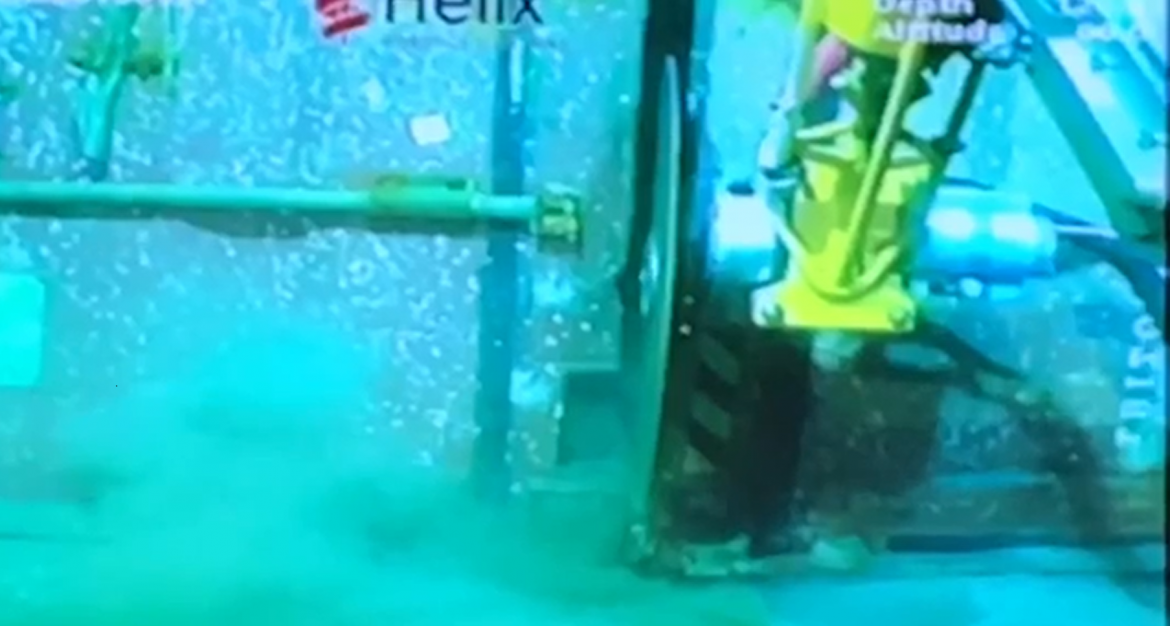
Diamond saw cutting containers apart 
Scooter batteries
- 16 April: Smooth sea lift of five stacked containers
The MV Pride has successfully recovered 19 containers lost overboard the YM Efficiency since the salvage operation commenced off the Hunter Coast on 6 April.
This includes a large stack of five containers dismantled and lifted overnight.
The containers were compared against the vessel’s manifest and are believed to hold bicycle and truck parts, cameras and homewares.
The salvage operation is on schedule and based on ROUV surveys to date, the current rate of recovery is estimated at four containers each day. The long-range weather forecast indicates favourable conditions for the next seven days of operations.
Waste processing of nine containers offloaded at the Port of Newcastle early this week is expected to be completed by tomorrow (17 April). All emptied containers will be sent to scrap for processing.
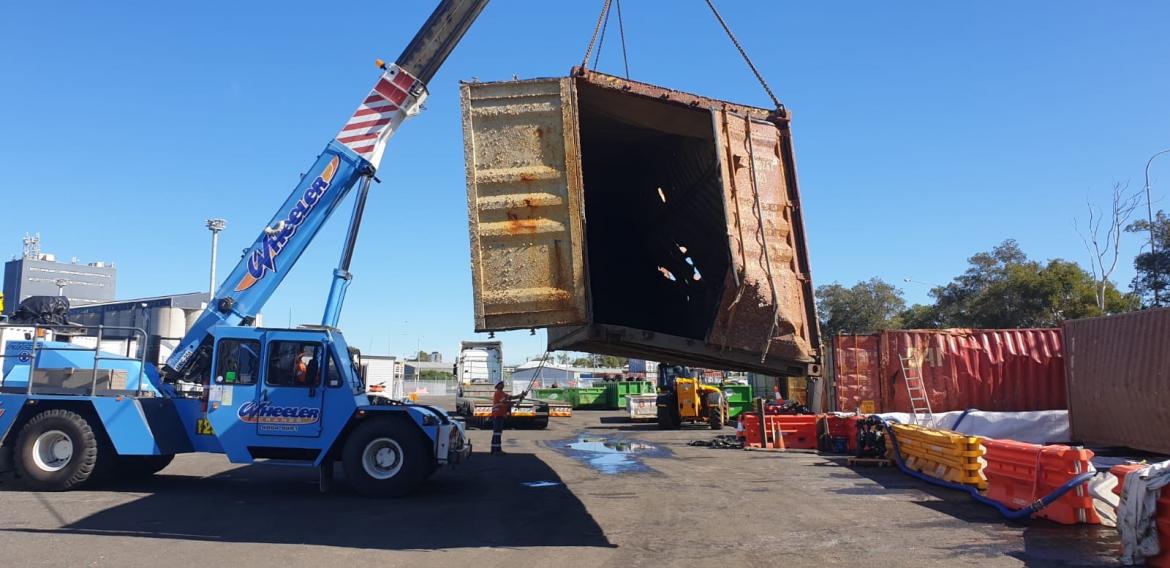
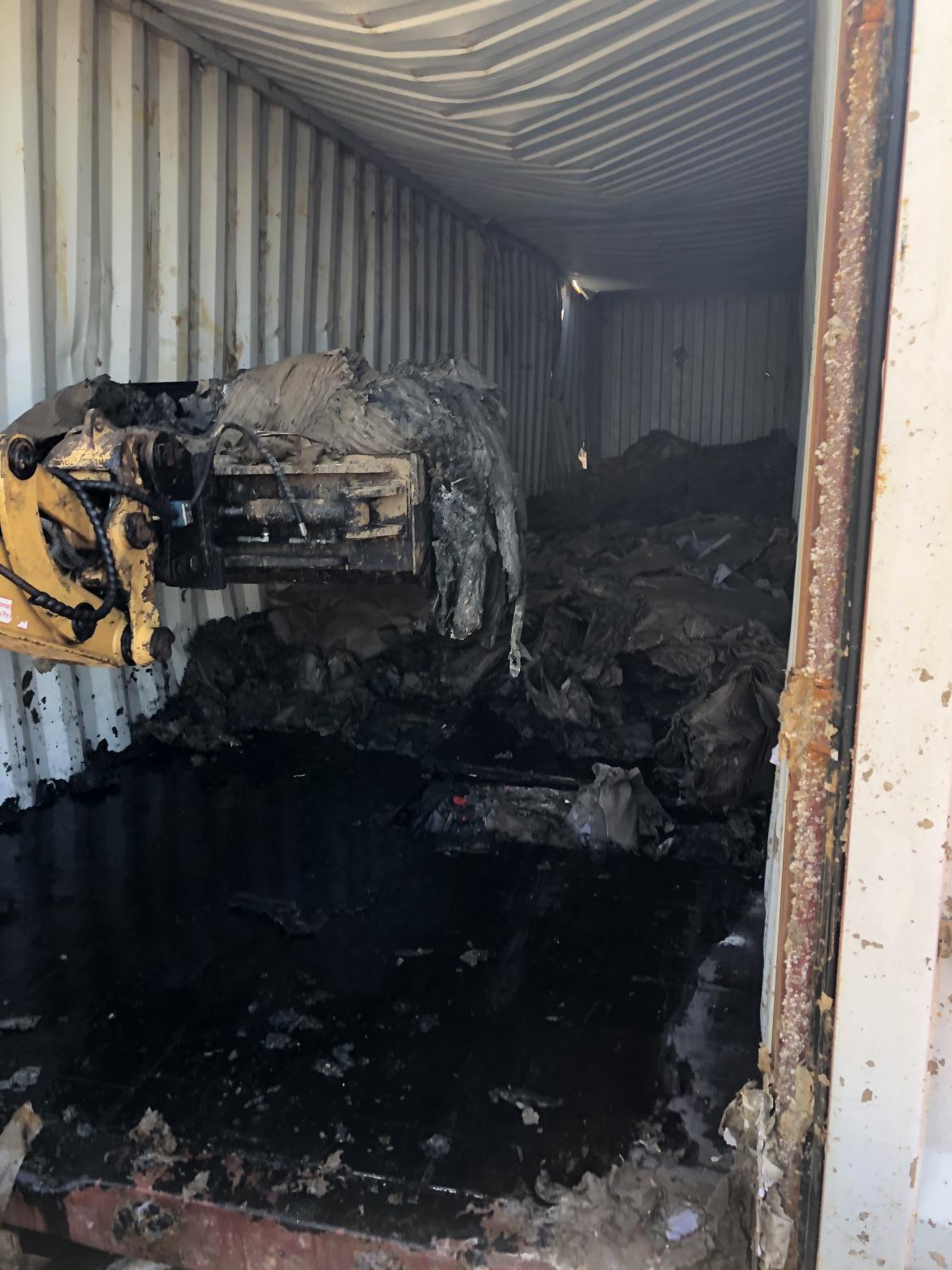
- 15 April: Successful upload of four damaged containers
Hardwood, tyres, furniture and plastic jars were among the contents of four damaged containers sea lifted onto the vessel MV Pride overnight.
Crew recovered the four broken containers that proved difficult to retrieve from the seabed at site #17, due to their poor condition.
One container was almost empty and held the remnants of its cargo of plastic jars, which were captured and stowed aboard.
MV Pride’s heave compensating crane recorded a 220-tonne load of the full container of hardwood, which dropped to 50 tonnes once the container was drained of seawater.
The vessel has relocated to site #29, to retrieve a stack of five containers in good condition, while waste processing of nine containers continues at Port of Newcastle.
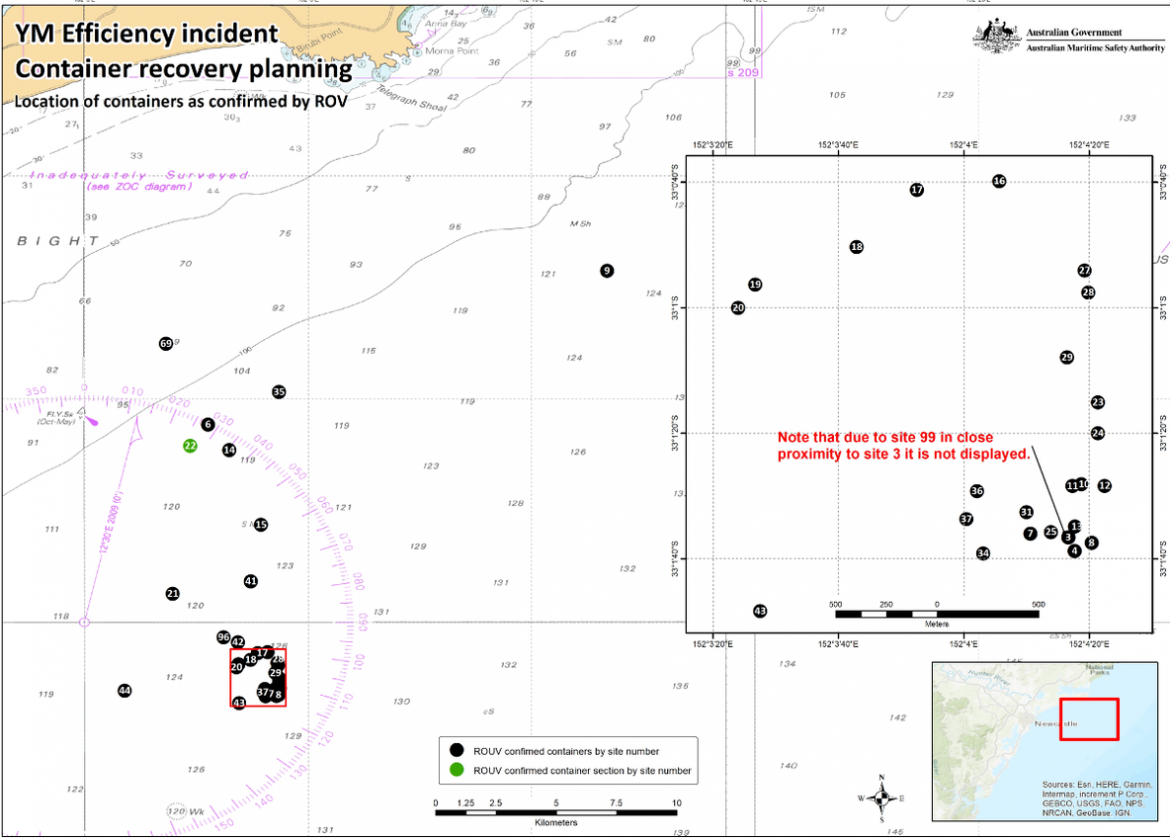
- 14 April: waste processing of nine containers underway
Nine containers from the YM Efficiency salvage operation have been safely offloaded at the Port of Newcastle and waste processing is now underway.
Seven containers were recovered between Thursday (9 April) and Saturday (11 April).
The containers housed machinery, scooters, furniture, plastic and utility trucks.
On Sunday poor weather set in with 30-knot SW winds and 4-metre swell, giving the MV Pride an opportunity to return to port to offload the containers for waste processing and undertake load handling deck modifications, repairs to the steel basket and construction of a landing frame for a spreader.
The vessel has since returned to sea and crew are working to separate two very damaged containers at site #17.
See our photos below and footage of the first container to be offloaded from MV Pride for waste processing.
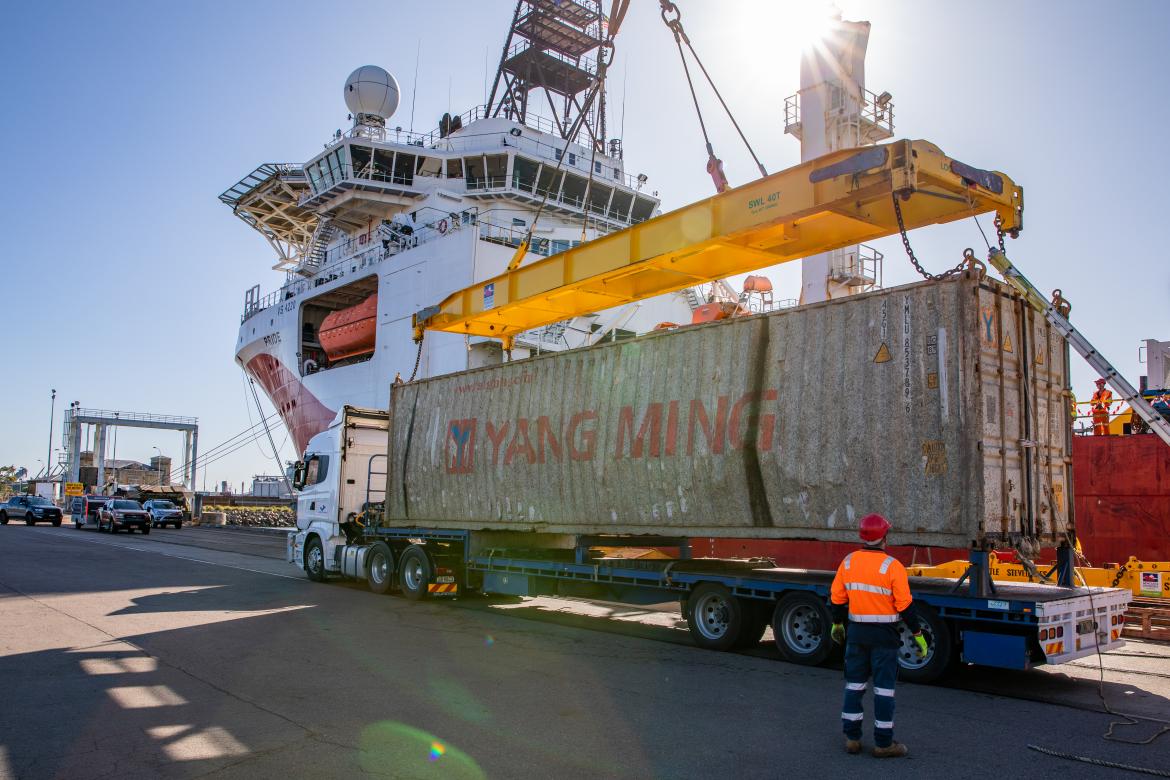
The first container is offloaded from the MV Pride at Port of Newcastle on Sunday. 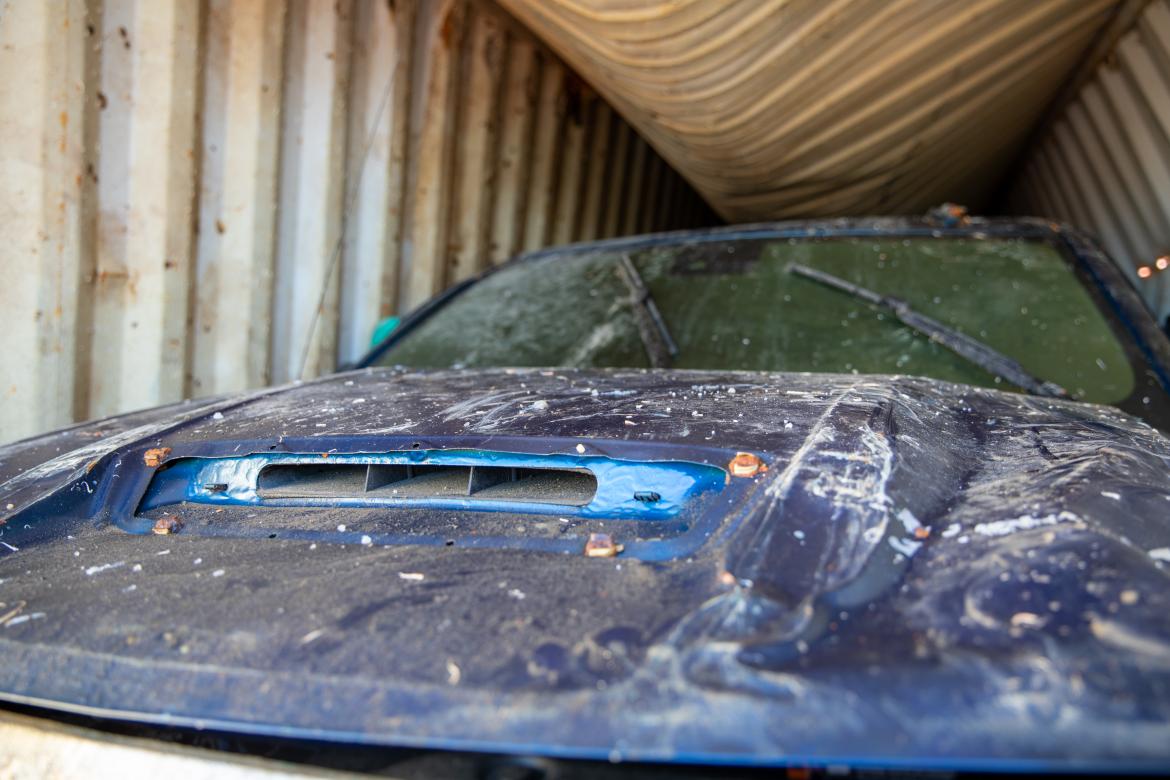
Utility truck is delivered to Port of Newcastle for waste processing. 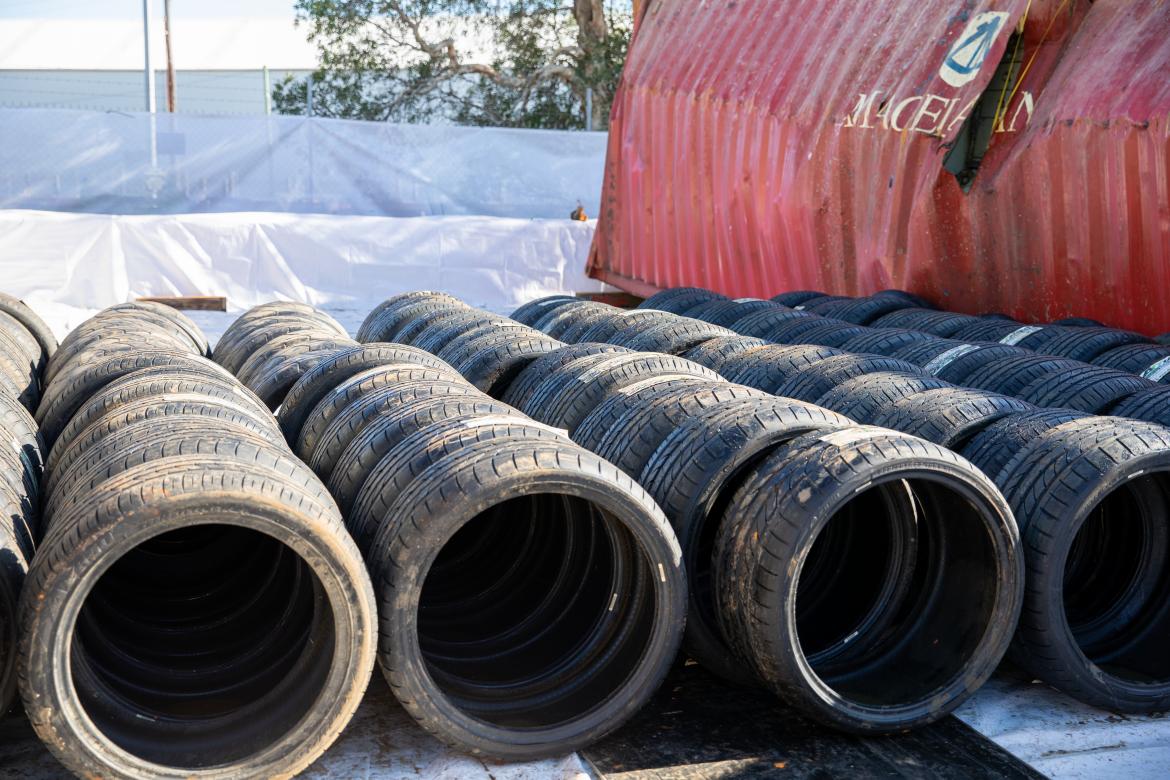
Tyres offloaded and ready for processing. 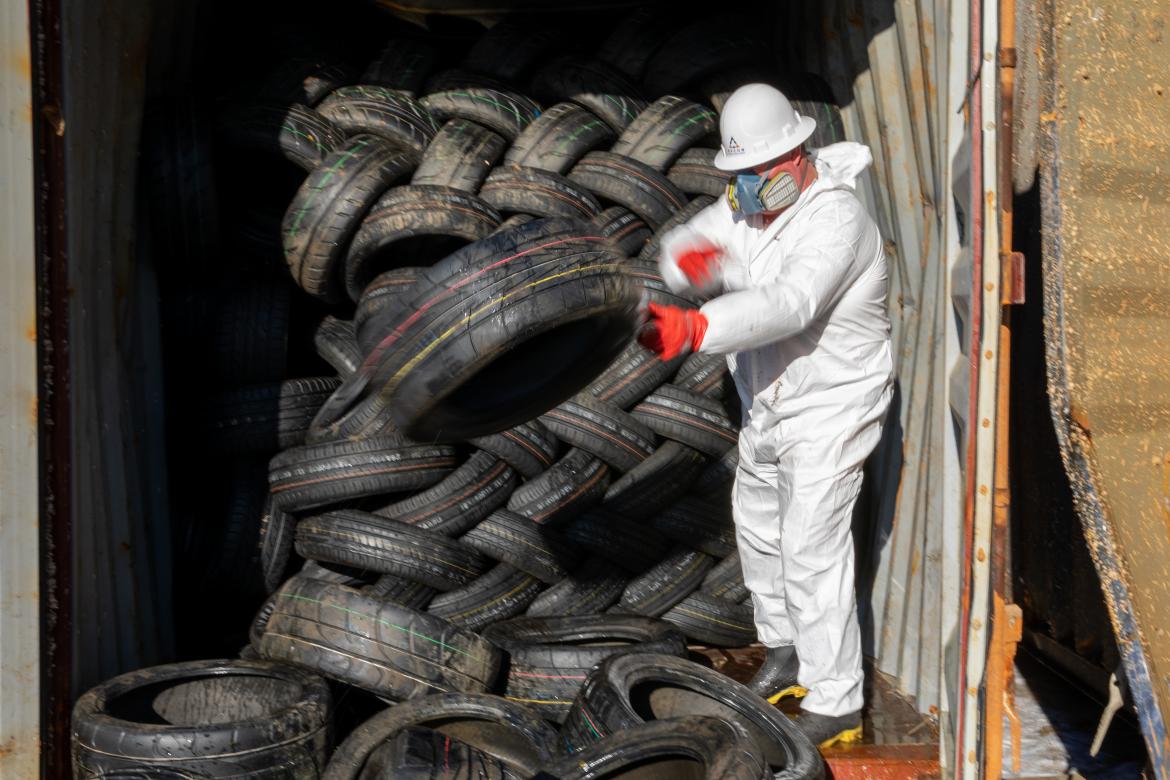
- 8 April 2020: two more containers recovered and two missing containers located.
During pre-lift surveillance of one of the container sites, an additional two containers were identified for recovery that were previously unaccounted for. This site was previously believed to contain two containers joined together but with the better cameras aboard the MV Pride’s ROUV, it was discovered there are actually four containers at this site.
The finding means the number of shipping containers being salvaged as part of Operation Recovery – YM Efficiency, now total 62 and there are only 14 containers yet to be located.
Two more containers have been recovered since the last update and are now stowed on the deck of MV Pride intact. These containers are believed to contain tyres and paper products.
Vessel movement caused some delays to sea lifts overnight and improvements to handling arrangements are underway to improve the speed and safety of handling the recovery basket.
To date, three containers have been retrieved since Monday 6 April and there are 59 containers still to be recovered.
Check out our video footage of the remote underwater vessel connecting rigging to the steel recovery basket and lifting a container onto the MV Pride.
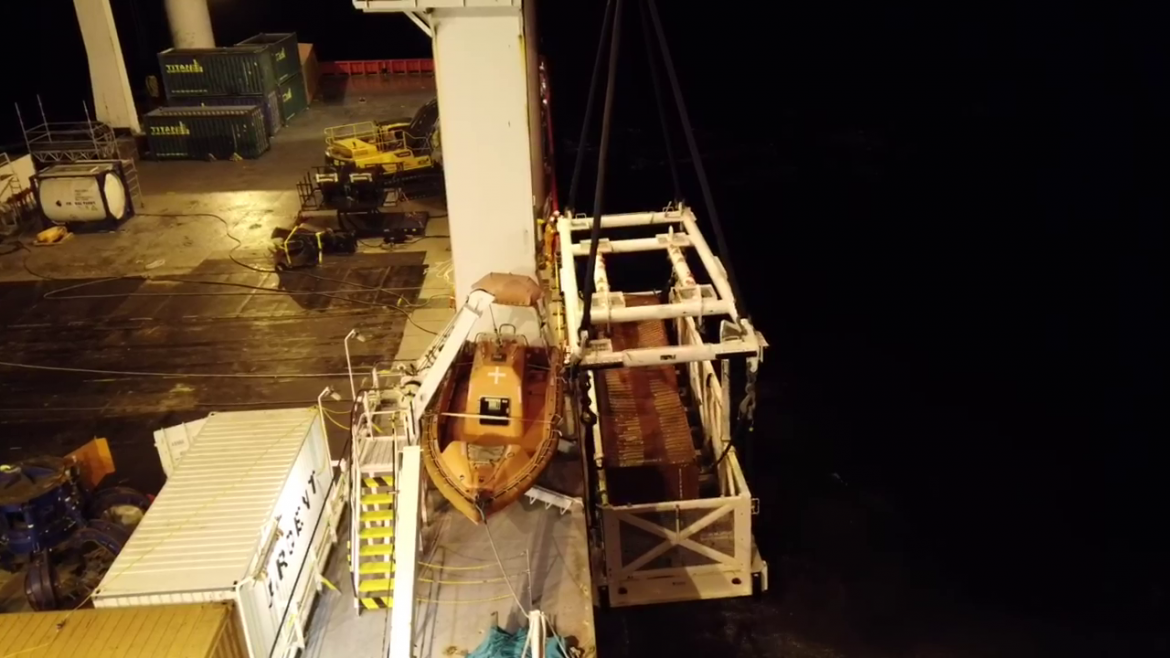
Basket with container being loaded onto the ship 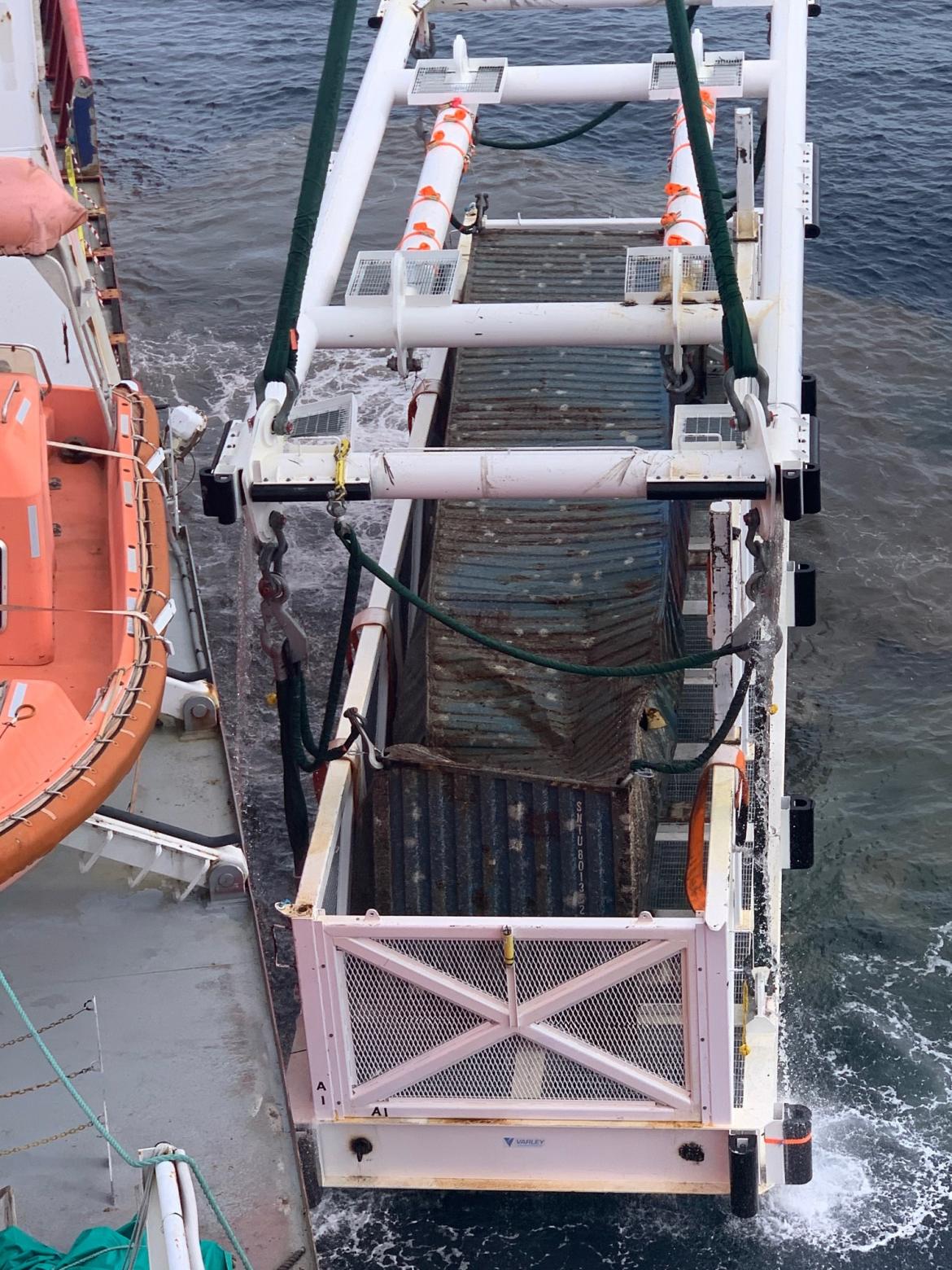
Basket with container
- 7 April 2020: first container retrieval
Retrieval work has begun with the first of 60 shipping containers lost from the container ship YM Efficiency successfully lifted from the seabed off the coast of Newcastle yesterday.
The subsea lift of the first container took place yesterday morning (6 April) at 0900 using a hydraulic crane and rigging, remote underwater vehicles and a specially manufactured steel basket.
According to the manifest the first container is believed to be carrying furniture products, the container was brought to the surface intact and will not be opened until brought ashore to the waste processing facility. The container was successfully lifted from the ocean bed, transferred into the basket and safely on-board the salvage vessel MV Pride without releasing any further pollution into the environment.
The MV Pride has begun salvage operations in clear weather with a moderate swell and slight seas, at the site of the main cluster of containers off the Hunter Coast in New South Wales.
Operation Recovery – YM Efficiency will continue throughout April, weather conditions permitting.
Subscribe to our mailing list for regular updates on the operation.
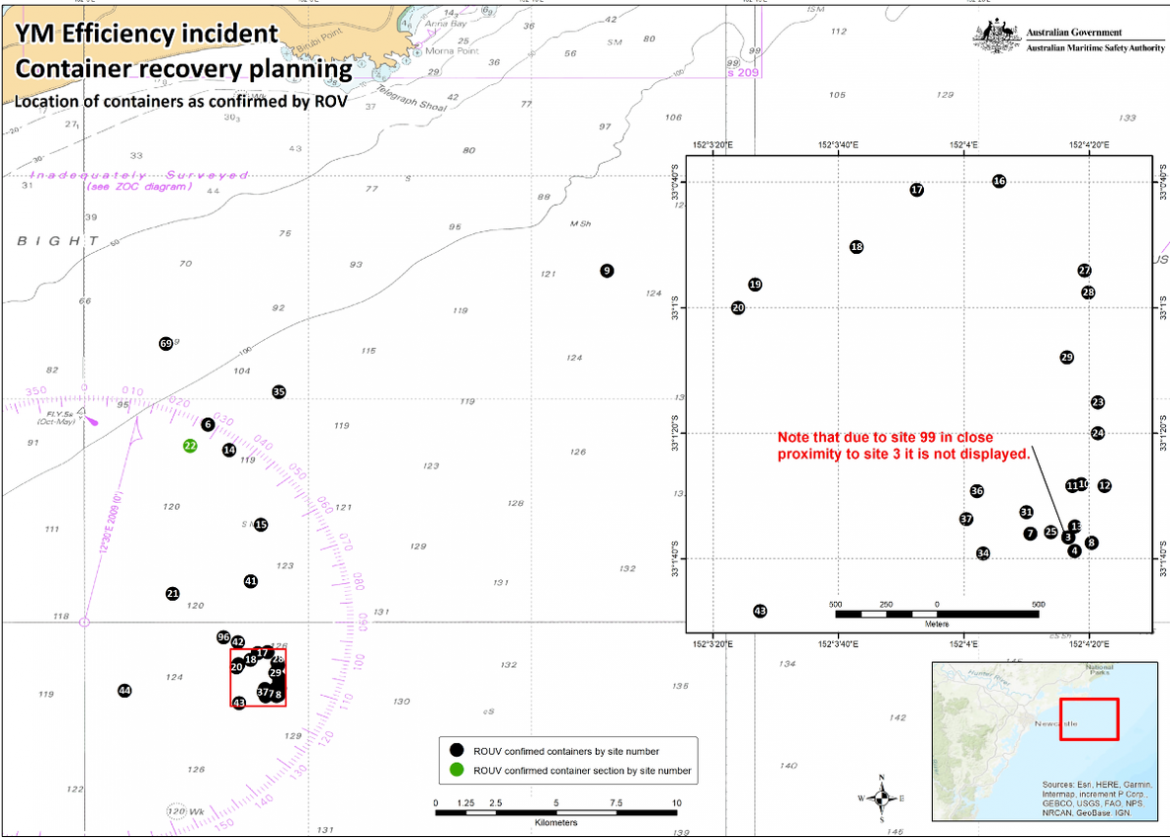
Location of containers 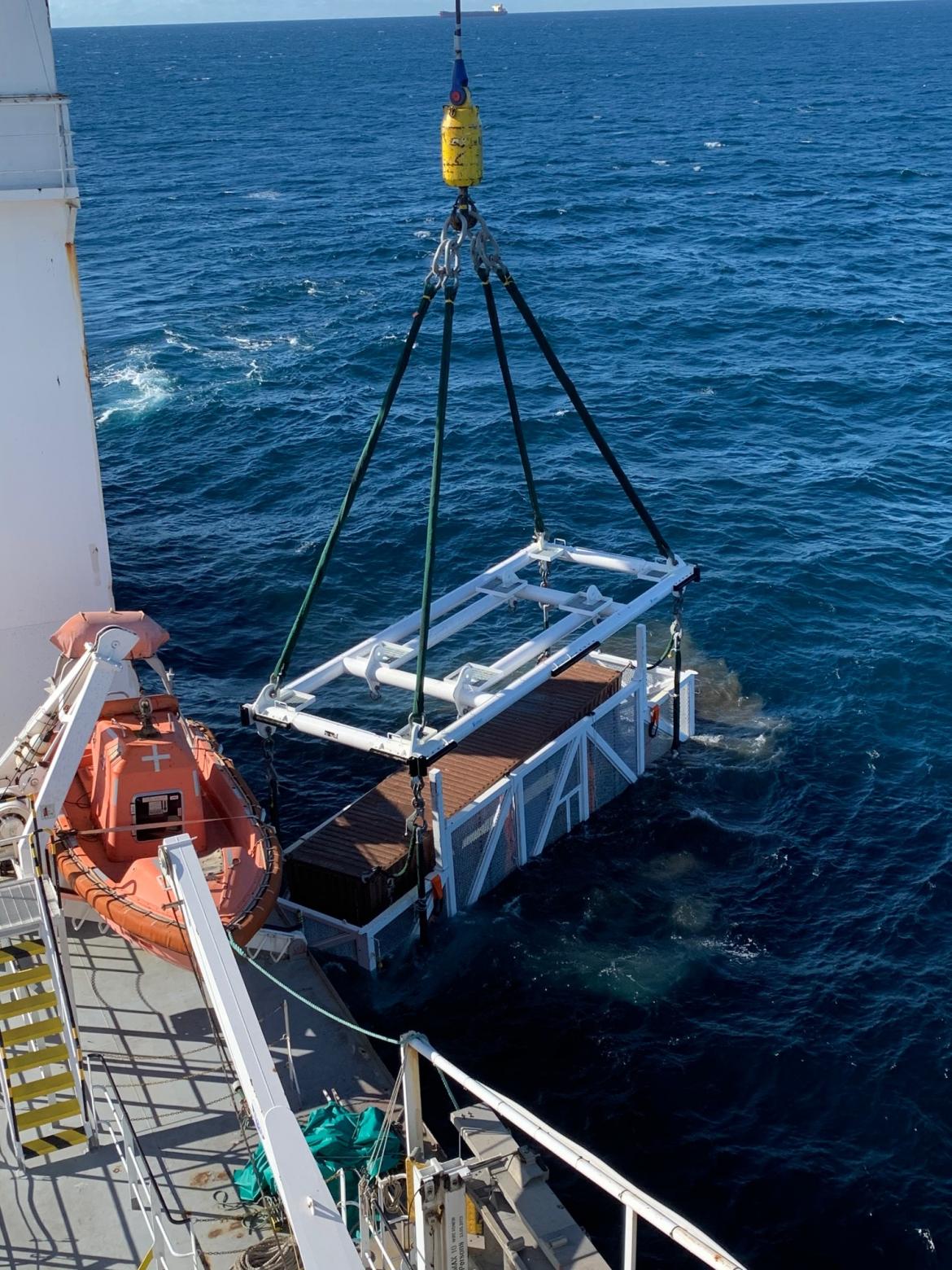
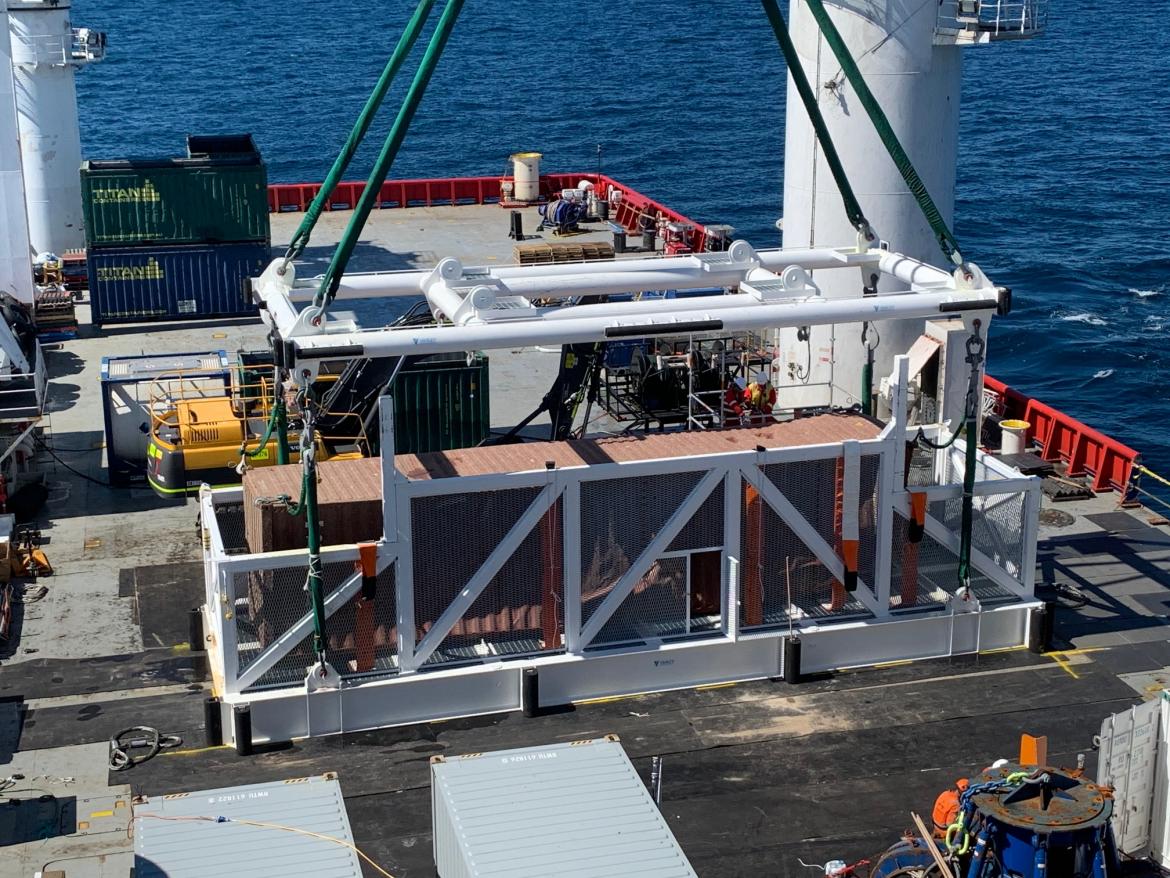
First container loaded onto the MV Pride, contains furniture products.
- YM Efficiency ATSB report and salvage update
If you missed out on attending one of our community information sessions in the Newcastle region last month, you can view and download our presentation on the response to date and overview of the salvage operations.
We expect the salvage to start next month and to take around four weeks, weather and conditions permitting.
You may also be interested to read the Australian Transport Safety Bureau’s (ATSB) report on the loss of containers overboard YM Efficiency.
The report’s findings concluded a structural failure of containers and components of the lashing system, combined with strong weather conditions, led to the loss of 81 containers and damage to another 62 containers.
You can read the ATSB’s recommended safety actions in the full report.
- Update—23 March 2020
Preparations are well underway to commence the clean-up operations. The recovery vessel MV Pride is expected to arrive in Newcastle in early April and we will update you once the date is confirmed. The Waste Management Plan for all onshore processing has been reviewed and approved by the NSW Environmental Protection Agency and AVCON Projects has been confirmed as the contractor to manage all onshore waste activities.
We have recently signed a contract with Subsea Pty Ltd to conduct additional searching for the 16 remaining containers not found during the initial search. The search area has been defined based on an analysis of the ship’s track and previous data collected through the subsea scanning. Work commenced this last week and will continue until the first week of April.
This timing should allow AMSA to negotiate a possible contract extension to remove any newly identified containers during the current project.
- Background
On 1 June 2018 the container ship YM Efficiency lost 81 containers overboard into Australian Commonwealth Waters, on the Newcastle-Port Stephens coast.
Five containers have been removed and there are 16 containers yet to be located.
Contractors removed approximately 1040 tonnes of pollution from around 400 kilometres of shoreline including plastics, furniture, tyres and paper products.
Leaving the containers in-situ poses an unacceptable environmental risk for the local community and future generations. It also presents a safety risk to local fishers. On 12 December 2019, we signed a contract with Ardent Oceania for the removal and disposal of 60 containers.
The salvage operation will start in March 2020, and the recovery of the containers is expected to be completed within a month, subject to weather conditions.
Debris recovered from the ocean, will be transported to a specially constructed waste reception facility in the Port of Newcastle.
Here the waste will be classified, stored, transported and disposed of according to NSW Environmental Protection Authority Waste Guidelines.
Risk mitigation will be undertaken to reduce any effects on the marine and coastal environment during the pollution recovery operations.
Getting the job done
- Ardent Oceania will be tasked to recover the containers, debris and other pollution from the seabed using an offshore salvage vessel, equipped with specially designed salvage tools.
- A remotely operated underwater vehicle (ROUV) will be deployed to support recovery operations. The ROUV is equipped to manage crane strops and wires, cut containers to separate them or create water egress holes and to pick up loose debris.
- A crane will deposit a large custom fabricated metal basket near the container and the ROUV will assist with attaching the crane to the container and lift it into the basket. The basket sides are enclosed with small mesh to minimise any spill during lifting and recovery operations.
- On surfacing, the basket and container will be slowly lifted to drain, then removed by crane for storage on the ship.
- There will be no access to containers and the container and contents will be secured until brought ashore and managed according to NSW Environmental Protection Authority Waste Classification Guidelines.
- If a container can’t be lifted into the basket, the crane will load debris and container components into the basket with a hydraulic grab. Once on board, loose debris will be placed in enclosed bins for removal in port.
- A small workboat will scour the local sea surface to retrieve any debris which may escape during a lift.
- The ROUV will assess remaining seabed debris and help guide a crane grab to clear the site.
- Finally RUOV will survey the site and provide evidence the site is clear of debris before moving to the next container location.
Onshore containment and disposal
Port of Newcastle will host a temporary area to receive, manage and transport recovered waste.
A bunding area will be constructed to prevent water pollution from the site entering Port waters.
The waste management plan and processes will be reviewed and agreed to with NSW EPA to ensure consistency with their regulatory requirements.
Biosecurity protocols have been addressed with both Australian Border Force and the Department of Agriculture.
Cost Recovery
Since the initial clean-up AMSA has attempted to engage with the Taiwanese owners of the YM Efficiency, Yang Ming, about their ongoing responsibility to remove the remaining containers from the seafloor.
Yang Ming and their insurers Britannia P&I have taken a position that they do not believe that the containers constitute pollution.
The ship’s owners Yang Ming are responsible for retrieving containers and meeting the costs of retrieving containers - the principle being that the polluter pays. Yang Ming’s failure to fulfil their obligations to retrieve the containers has meant that AMSA has stepped in to start the recovery operation. AMSA intends to recover all costs associated with the clean-up from Yang Ming and its insurer Britannia P&I.
Pagination
- Previous page
- Current page 25
- Next page